
darian j. shump
lapsed academic, occasional artist
About
I’m a former career grad student and instructor turned amateur game dev. My personal interests center primarily around narrative design, but I’ve also developed a passion for production and small-team mentorship as a result of my professional experience adjacent to the games industry over the last few years.In my current role at Rushdown Studios, I’m splitting my time between providing external production support for our partner studios and overhauling our internal recruitment and onboarding processes with an eye toward providing a more personal — and personalized — candidate experience. Outside of Rushdown, I serve on the Board of Directors for Tech Valley Game Space and IGDA Albany, two local non-profit organizations based in the Capital Region.Beyond gaming, I still tend to think of myself as an “independent scholar” before anything else. My research in that capacity builds upon work I pursued in my previous life: I’m especially interested in visual culture in contemporary Japan, including artistic representations of shape-shifting yōkai and the ways their transformations manifest across print, animated, and interactive media. The way I see it, images of shape-shifters quite literally embody the myriad relationships between human and non-human animals — and in doing so, force us to reconsider our relationships with the environment.
CV
Education
2019-2021 (partial coursework)
M.A., East Asian Languages and Cultures
Florida State University
2016-2019
M.A., History and Ethnography of Religions
Florida State University
2010-2014
B.A., History / Religious Studies
Stetson University
research themes
Visual Culture
Identity Formation
Anti-State Resistance
professional experience
January 2025-present
Associate Producer / Acting Hiring Lead
Rushdown Studios
September 2024-December 2024
Production Assistant
Rocket Science Corporation
January 2024-December 2024
Associate Recruiter
Rocket Science Corporation
April 2022-January 2024
Administrative Coordinator
Center of Excellence in Digital Game Development
Rensselaer Polytechnic Institute
teaching experience (instructor of record)
Fall 2021
Religious Ethics and Moral Problems
Florida State University
Summer 2018-Spring 2021
Multicultural Dimensions of Film and 20th Century Culture
Florida State University
Spring 2018
Religion and 20th Century Fantasy Literature
Florida State University
teaching experience
(teaching assistant)
Religion and 20th Century Fantasy Literature
Florida State University
Religious Ethics and Moral Problems
Florida State University
Zen Buddhism
Vanderbilt University
Self and World (First-Year Seminar)
Stetson University
Religions of the East
Stetson University
book chapters
2024
With Williams, Erin. "Silver or Steel? Critiquing Rational Choice in an Irrational World." In The Witcher and Philosophy, ed. Matthew Brake and Kevin S. Decker. Hoboken, NJ: Wiley / Blackwell.
2023
“Lost Souls and Old Sons: Augustinian Theodicy and the Path to Redemption in NBC’s Constantine.” In Theology and the DC Universe, ed. Roshan Abraham and Gabriel Mckee. New York, NY: Lexington Books / Fortress Academic.
2017
“The Accidental Hero.” In Deadpool and Philosophy, ed. Nicholas Michaud and Jacob Thomas May. Chicago, IL: Open Court Publishing Company.
book reviews
2020
Sem Vermeersch. A Chinese Traveler in Medieval Korea: Xu Jing’s Illustrated Account of the Xuanhe Embassy to Koryo (Honolulu, HI: University of Hawai’i Press, 2016). In Reading Religion. Online.
2019
Hwansoo Kim. The Korean Buddhist Empire: A Transnational History, 1910-1945 (Cambridge, MA: Harvard University Press, 2018). In Reading Religion. Online.
public scholarship
2020
“World-Breaker: Feuerbach, Kierkegaard, and the Divine in FX’s Legion.” On AndPhilosophy.com: The Blackwell Philosophy and Pop Culture Series. Online April 13.
2017
“Self and Identity in Gotham.” On AndPhilosophy.com: The Blackwell Philosophy and Pop Culture Series. Online January 23.
2016
“Personhood in Fullmetal Alchemist: Brotherhood.” On AndPhilosophy.com: The Blackwell Philosophy and Pop Culture Series. Online June 3.
academic presentations
2021
“Tempering the Sword: An Analysis of the Near Eastern Covenant in Deuteronomy 13:2-19, 17:2-7, and Qur’ān 9:5.” 12th Annual Meeting of the Society for the Study of Muslim Ethics, Virtual via Zoom, January 7-10.
2020
“It Wears a Human Face: Superheroes, Schizophrenia, and Subjectivity in FX’s Legion.” 18th Annual Graduate Student Symposium, Florida State University, February 14-15.
2019
(in absentia) “Becoming Uyghur: Resistance and Religion in Modern Xinjiang.” SECSOR (Annual Meeting), Greenville, NC, March 8-10.“Secret Lives, Fragmented Selves: Ms. Marvel and Muslim American Youth.” 17th Annual Graduate Student Symposium, Florida State University, February 22-23.
2018
“A New Religion for a New Korea: Won Buddhism as a Nationalist Construction, 1910-1945.” 3rd Annual Master’s Conference in Religious Studies, Duke University, February 23-24.
2017
“The Truth of Il-Won: Neo-Confucianism, Nationalism, and a New Religious Movement in Colonial Korea.” 1st Annual Buddhist Studies Graduate Conference, Florida State University, November 10-11.“Unbreakable: Contested Boundaries and Conflicting Identities in Marvel’s Luke Cage.” 74th Annual SCMLA Conference, Tulsa, OK, October 5-7.“Muslim Brethren? Sufism, Terrorism, and Uyghur Identity in Post- Republican China.” 15th Annual Graduate Student Symposium, Florida State University, February 19-21.
departmental service
(fsu, religion)
Summer 2020
Research Assistant, Dr. Adam Gaiser
Project: Sectarianism in Islam: The Umma Divided
2019-2020
Co-Director
18th Annual Graduate Student Symposium
2018-2019
Chair, Media and PR
17th Annual Graduate Student Symposium
languages
Arabic - Elementary in Reading
German - Elementary in Reading
Japanese - Intermediate in Reading and Writing,
Elementary in Speaking
Writings
the backlog
Game Analysis [Lite]
animated + print media
Retrospective, Part 5
Placeholder.
January 1, 2025 -
June 30, 2025
Played: 12
Finished: 5
Abandoned: 5
In Progress: 2
July 1, 2024 -
December 31, 2024
Played: 15
Finished: 9
Abandoned: 5
In Progress: 1
Placeholder.
Top Five
Horizon Zero Dawn
Saga Frontier 2 Remastered
Return of the Obra Dinn
DMC: Devil May Cry
Sniper Elite 4
Worst Three
Armored Core VI:
Fires of Rubicon
Inscryption
I Am Setsuna
Retrospective, Part 4

Placeholder.
July 1, 2024 -
December 31, 2024
Played: 15
Finished: 9
Abandoned: 5
In Progress: 1
January 1, 2024 -
June 30, 2024
Played: 11
Finished: 7
Abandoned: 2
In Progress: 2
Placeholder.
Top Five
Dredge
Placeholder.
Call of Juarez: Gunslinger
Placeholder.
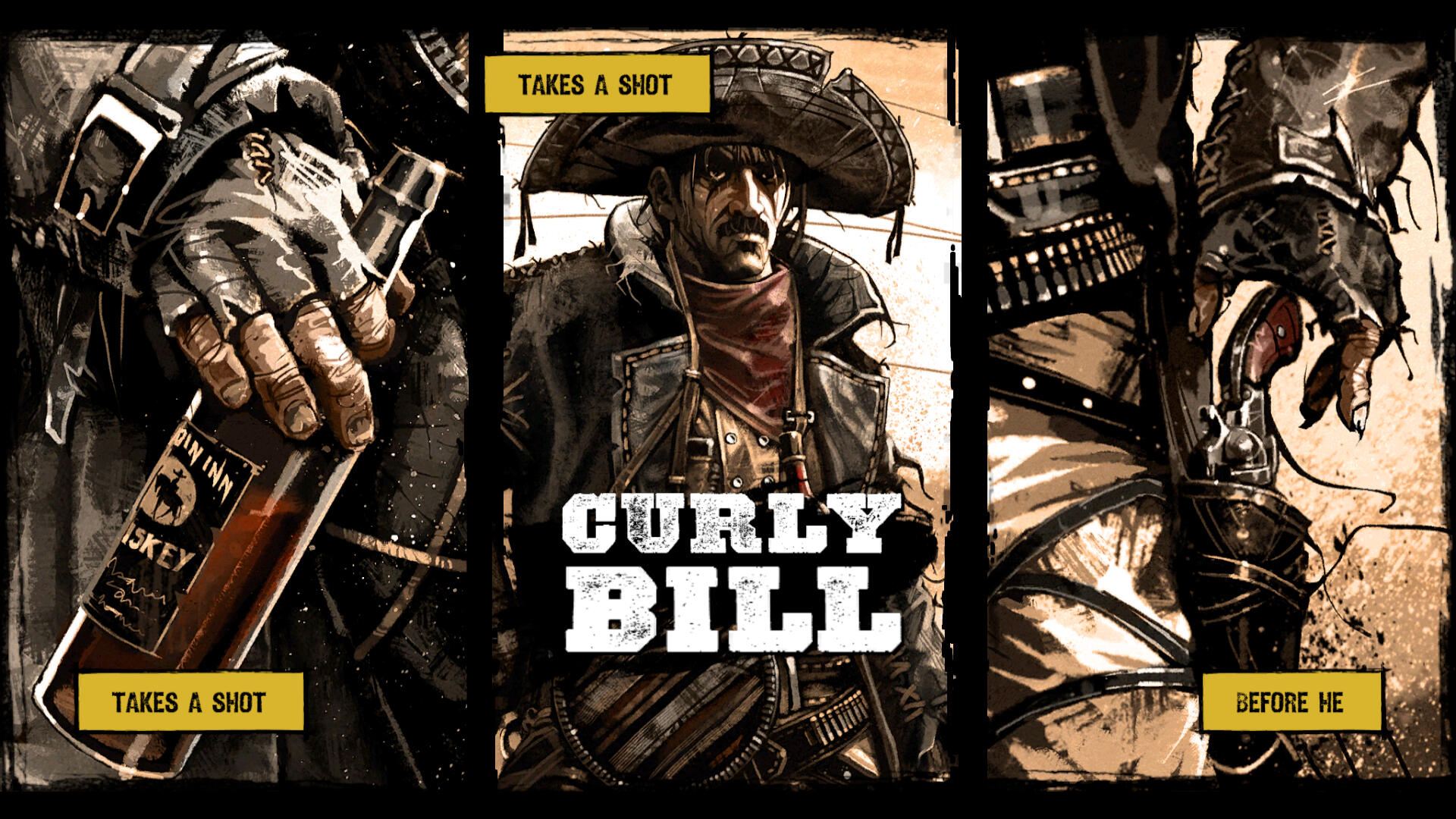
The Life and Suffering of Sir Brante
Placeholder.
Infamous: Second Son
Placeholder.
Dead Space (2023)
Placeholder.
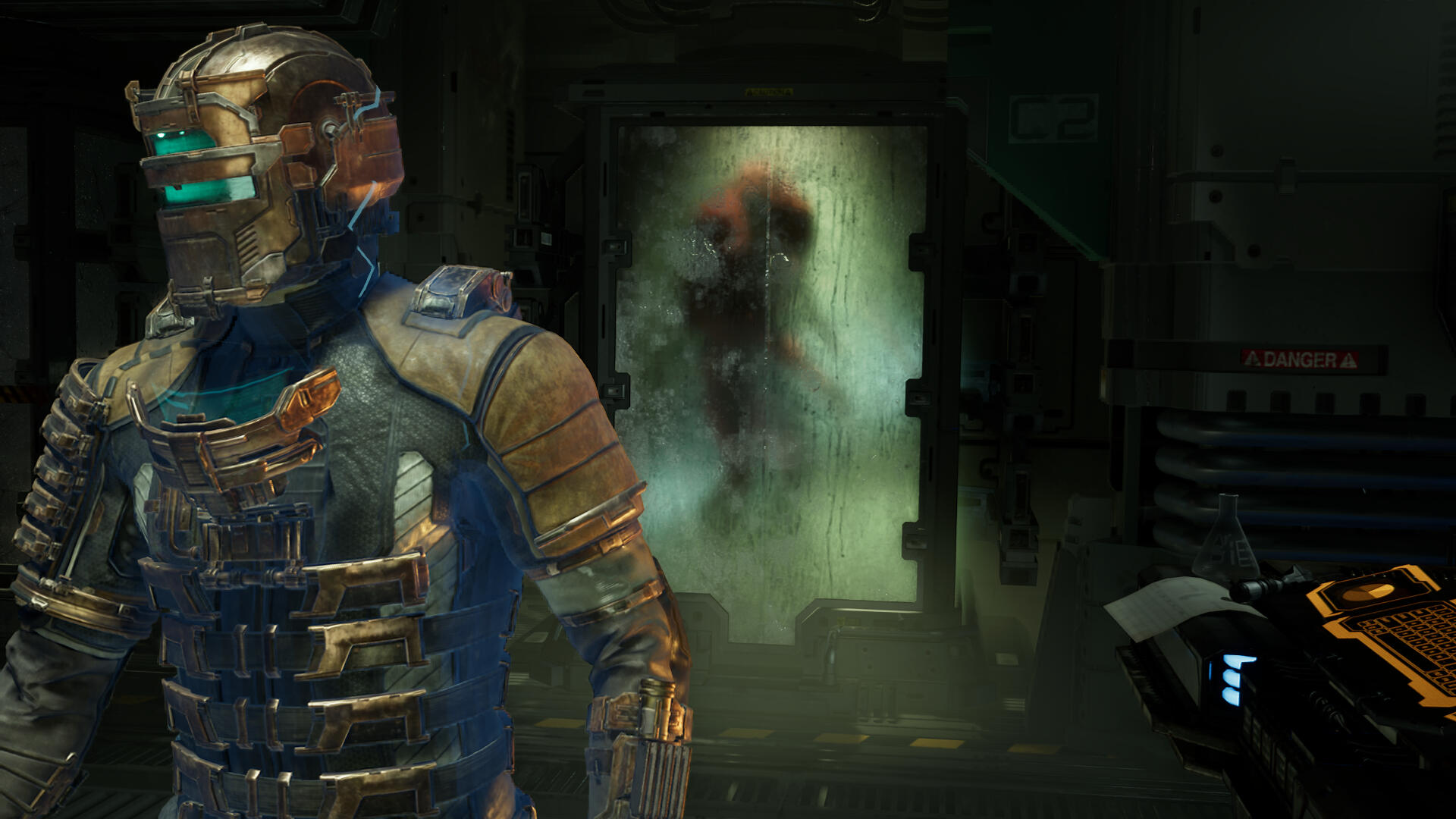
Worst Three
Hogwarts Legacy
Placeholder.
Ori and the Will of the Wisps
Placeholder.
Valheim
Placeholder.
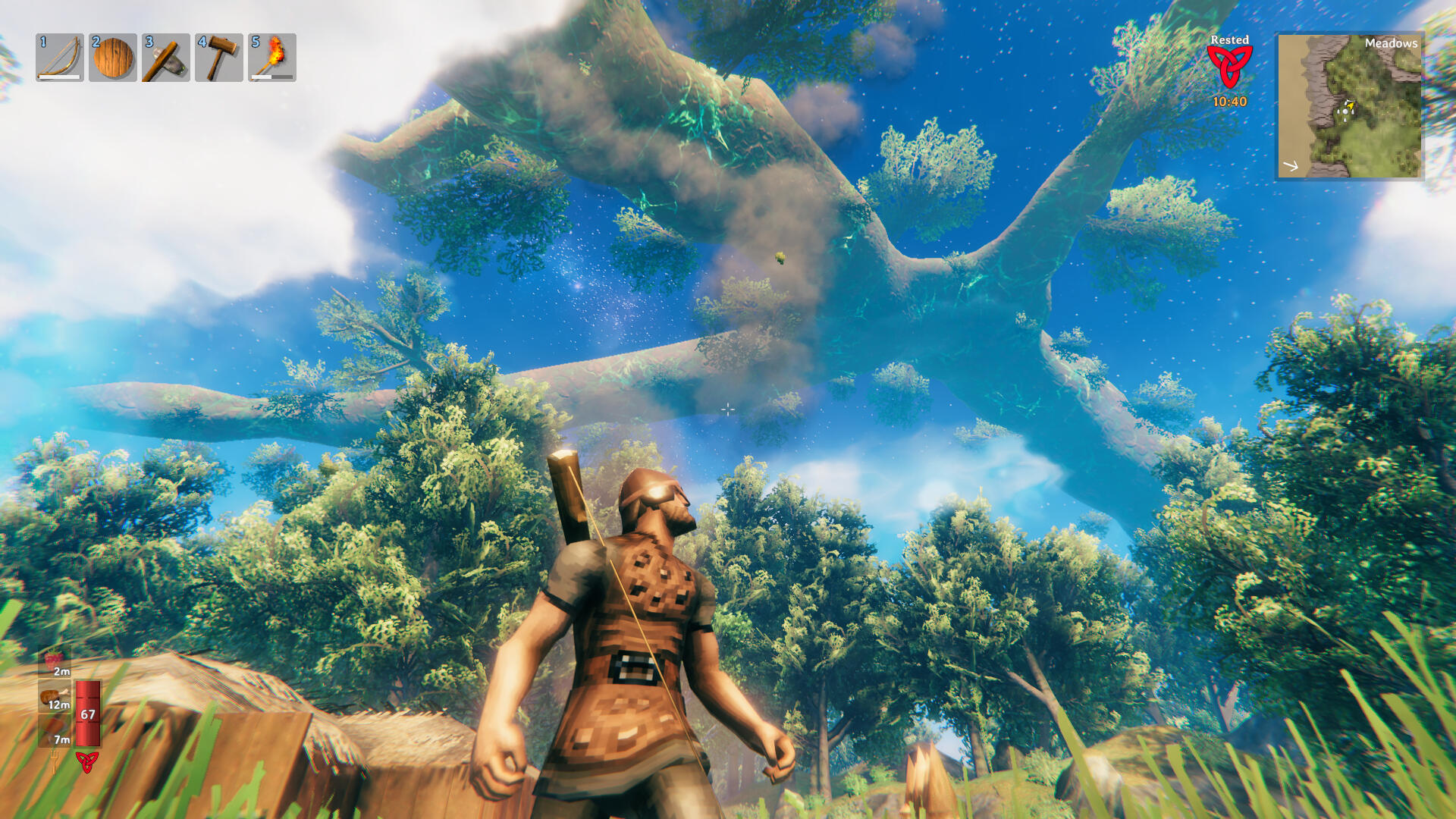
Retrospective, Part 3
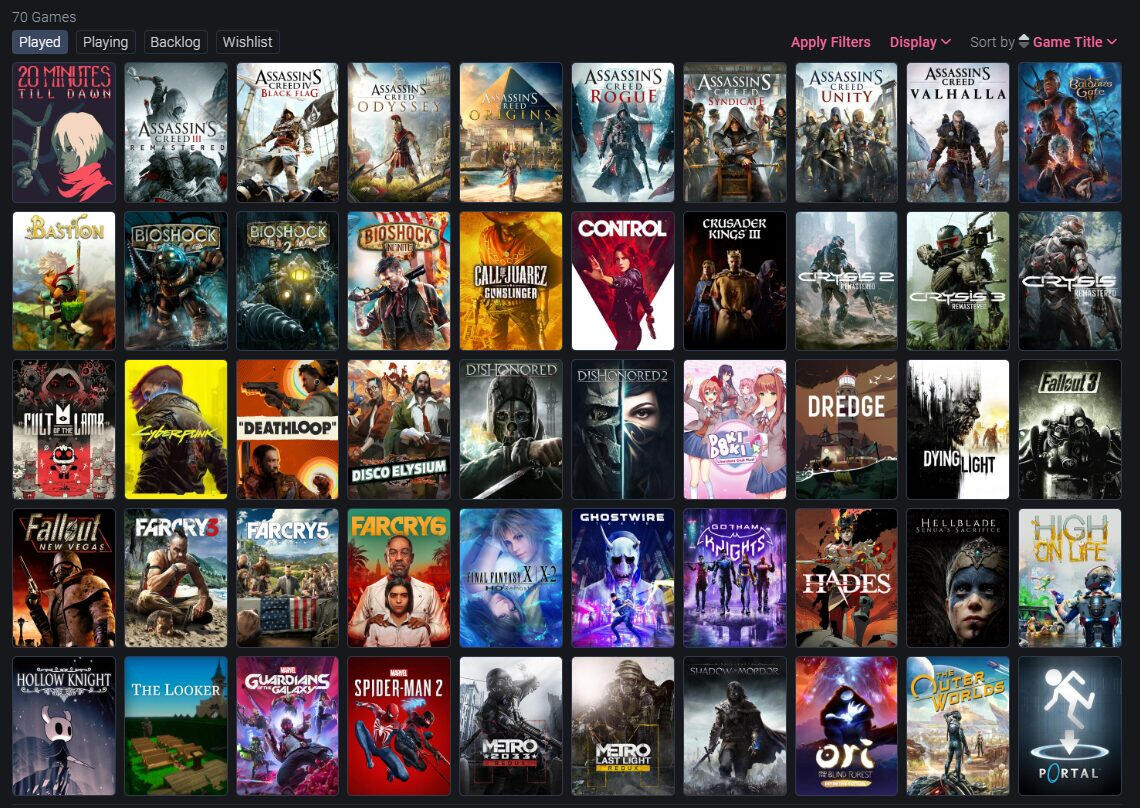
Another weird six months, but with quite a bit of positive momentum: I landed my first job in the games industry!Although recruiting isn't exactly the end goal, it's a toehold at a time when layoffs, shutdowns, and game cancellations are continuing at an unprecedented pace. Meanwhile, it feels like our studio's been expanding at an unprecedented pace, and my free time has become increasingly limited. I'm reminded at least in part of my time teaching -- but I'm finding that I enjoy the hectic nature of things more than I'd have ever expected.Of course, it also means that I've once again had much less time to actually focus on games outside of work.In terms of stats:
January 1, 2024 -
June 30, 2024
Played: 11
Finished: 7
Abandoned: 2
In Progress: 2
June 20, 2023 -
December 31, 2023
Played: 13
Finished: 10
Abandoned: 2
In Progress: 1
My only other excuse here is that I've continued to focus on longer, open-world rpgs, mostly because I'm still stubbornly working my way through the Assassin's Creed series. I did try to find a handful of shorter indie games to dig into between things, but only one ever ended up really sticking.With this in mind, it feels a little weird to try to piece together a Top Five and Worst Three; I'd only end up leaving out one of the nine games I actually finished this cycle. Instead, I want to switch it up and take a brief look at an eclectic Top Four, as well as two cases that exemplify my ongoing struggles with 3D Puzzle-Platformers.
Top Four
Marvel's Spider-Man 2
[24h]
Easily the most enjoyable game I played this cycle. Marvel's Spider-Man 2 captures the best elements of the previous two entries, but it never feels stale -- not least because it also manages to expand upon them in meaningful ways at the same time. Perhaps the best example is the map itself: Although the explorable world is larger, traversal is arguably more engaging than ever with the addition of the classic web wings and conveniently placed wind tunnels. Meanwhile, the combat is snappy, the narrative is poignant (plus original enough to not bore longtime fans), and that one sequence with Venom just feels right.
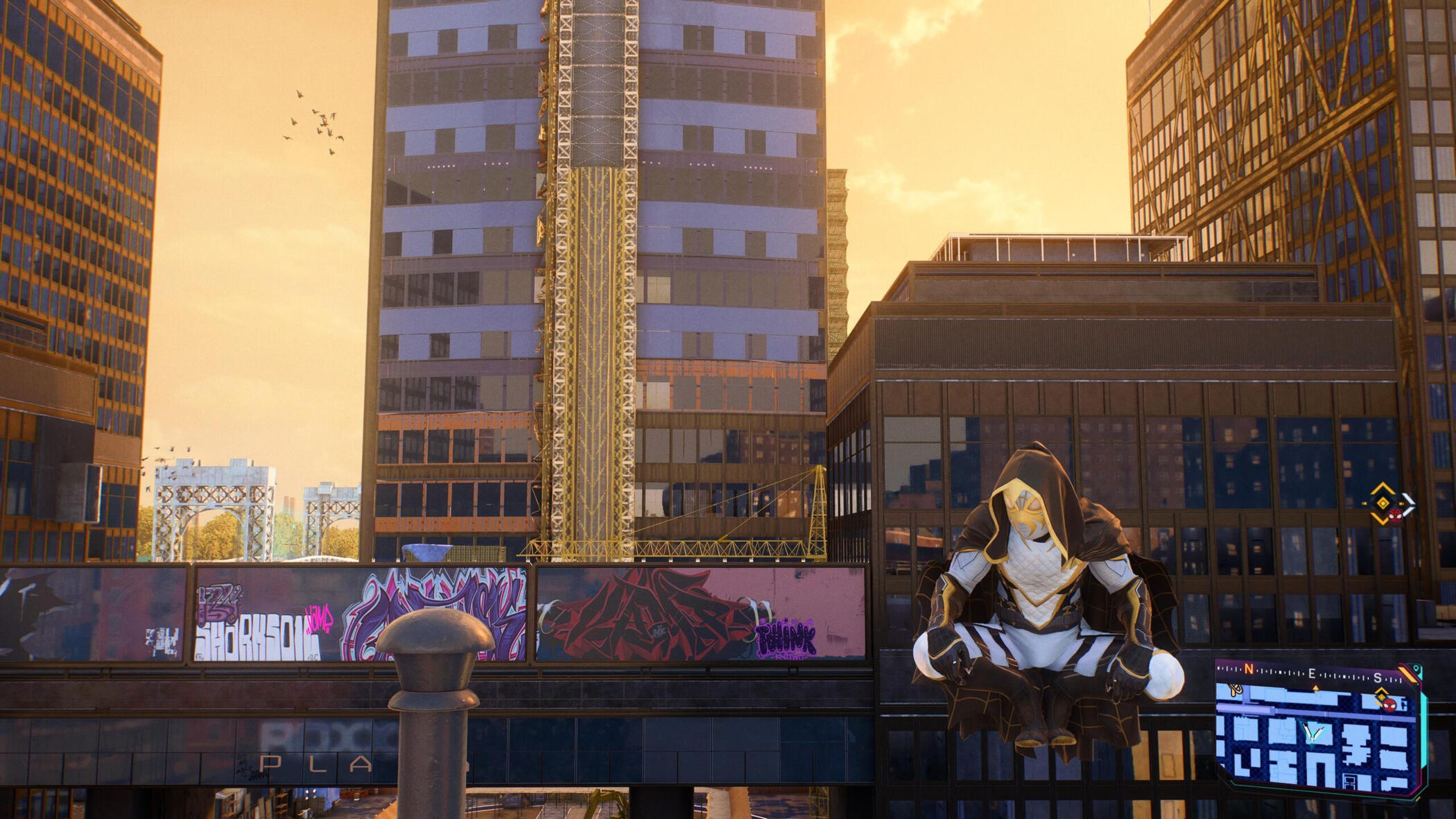
20 Minutes Till Dawn
[16h 24m]
One of the first games I played on the Steam Deck. The overall design and gameplay here isn't all too different from other games I've seen (and I think briefly played) on mobile, but the art direction really caught my attention in the first place and the weapon variety / character abilities kept hold of it for longer than I'd expected. In the end, it doesn't pretend to be anything that it's not and I think that's to be commended.

Crusader Kings III
[507h 30m]
I have a problem and it's this game. I first picked it up back at the height of the pandemic and I couldn't put it down, despite the fact that it's nothing like anything else I play regularly. Maybe it's the historian in me, but I've got a weakness for its approach to emergent gameplay -- and the sheer number of options available when it comes to choosing a ruler, growing a realm, and cultivating a dynasty. Even so, it wasn't until this year that I finally finished a run without mods and I think that means I can officially lay it to rest... Or so I keep telling myself, at least.
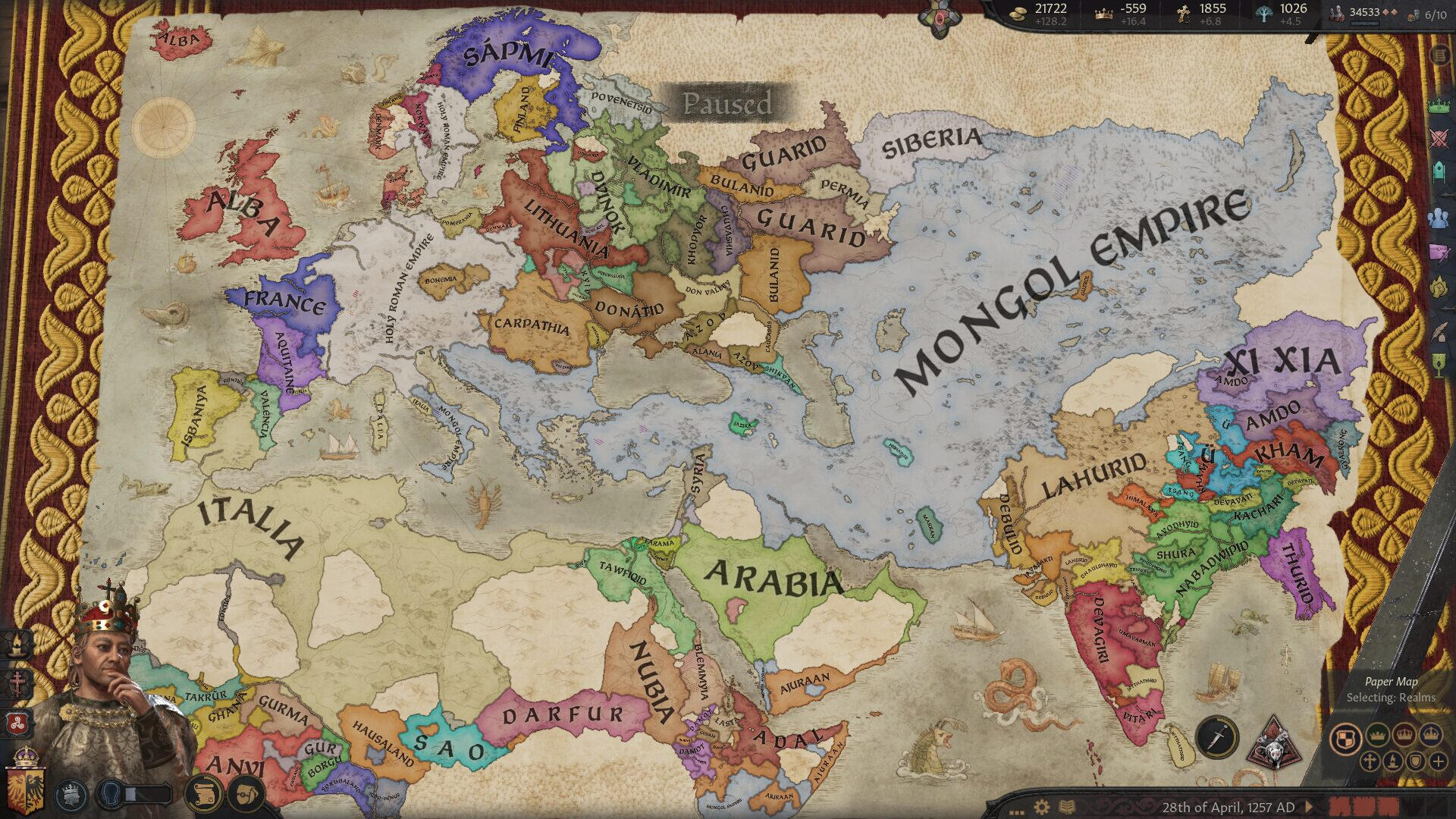
Assassin's Creed Origins / Odyssey
[49h 40m / 110h 32m]
I challenged myself back when I was on Twitter to finish the Assassin's Creed series by the end of 2024; I'm not sure I'm going to make it now, but at least playing these two takes a pair of the beefier entries off of the list. This was also my first playthrough of Origins after sinking dozens of hours into Odyssey back during the pandemic -- and I have to admit that as much as I still prefer Odyssey, Origins wins in terms of the relative depth and cohesiveness of its narrative. That being said, playing these back to back only deepened my biggest gripe with the series: I wish the default sprint and climb controls would actually stay the same for once!

Interlude:
3D Puzzle-Platformers
Portal 2
[6h 50m]
This is a weird one to try to explain. Portal 2 is an outstanding game and I didn't hate playing it, but it's also not something I'd have ever picked up or continued if it weren't for the batch of friends who insisted upon watching my stream on Discord. In that regard, it's one of the few 3D puzzle-platformers I've been able to finish, even though I was really more drawn to the narrative and voice acting than the level design or gameplay itself.As a result, and coupled with my attempt to play Jedi: Fallen Order last year and picking up Spyro Reignited this year, I finally realized something: My trouble with this genre almost always boils down to perspective.It doesn't matter if it's first- or third-person; whether it's the field of view or the positioning of the camera behind the character model, it almost always feels "restrictive," or maybe just "limited," in comparison to two-dimensional platformers. I still hesitate to say this is a problem with the games themselves, but I do think it makes it tricky to make them feel "right" in the modern world of gaming.Enter Spyro...
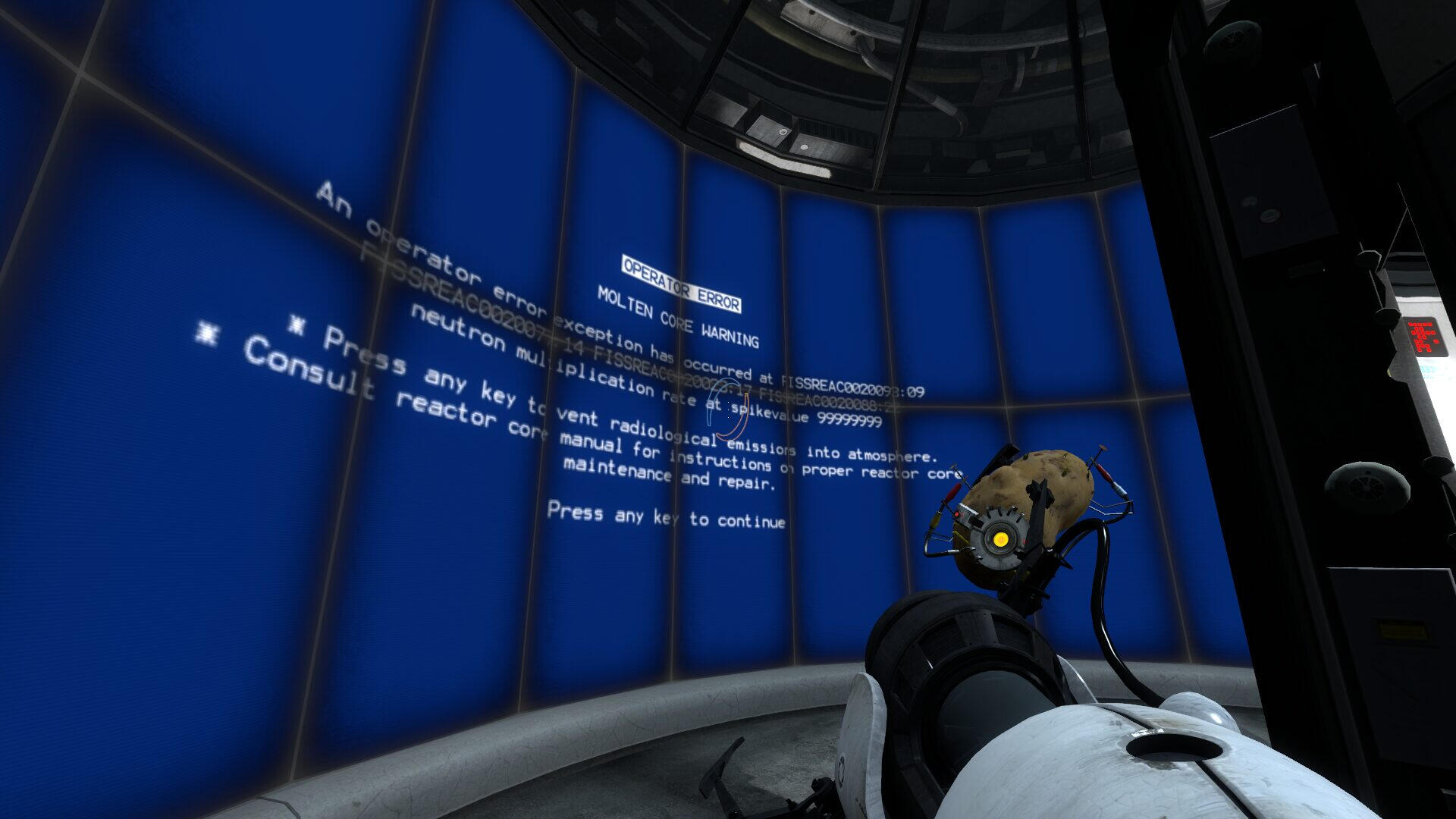
Spyro Reignited Trilogy
[3hrs, abandoned]
Which is another series that I shouldn't have had any problem finishing -- after all, I loved and lived for the original Spyro entries as a kid.But somewhere between then and now, I found myself fighting more with camera angles than actually playing the game. Although the Spyro remakes are masterfully done and do retain the original option to switch between Passive and Active camera modes, I'm not convinced that their relationship between character movement and player perspective stands up to the test of time. Put differently, I'm always keenly aware that I'm the one controlling Spyro, rather than feeling like I've become Spyro.Nobody is to blame here, of course, but it's an interesting phenomenon. Over the last twenty years, players (i.e., me) have increasingly been conditioned to expect a certain smoothness of gameplay, despite the fact that it's a subjective quality with ever-shifting goalposts. (There's a reason so many players disagree about the fixed camera angles in the early Resident Evil games, for example!) To need to fight a camera to solve a puzzle, advance, or otherwise survive in a modern game is an anachronism, or so I've convinced myself at this point.I admit there's definitely more to this thought process, but I'll leave it there for now and keep trying to force my way through 3D puzzle-platformers in the meantime. With luck, maybe I'll eventually be able to revisit Jersey Devil on PS1 to test my luck with another cartoonish, purple, horned creature...
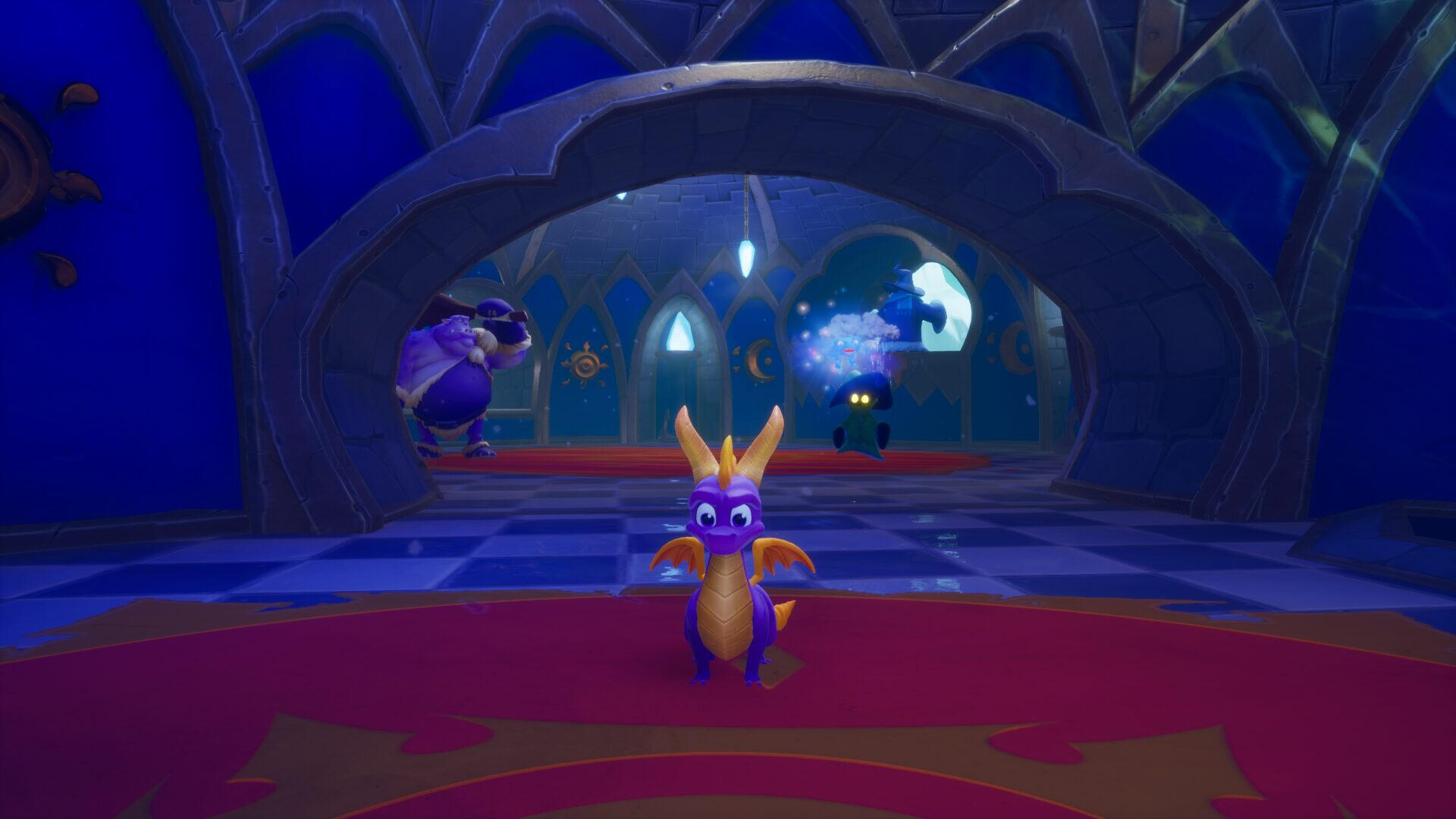
Retrospective, Part 2
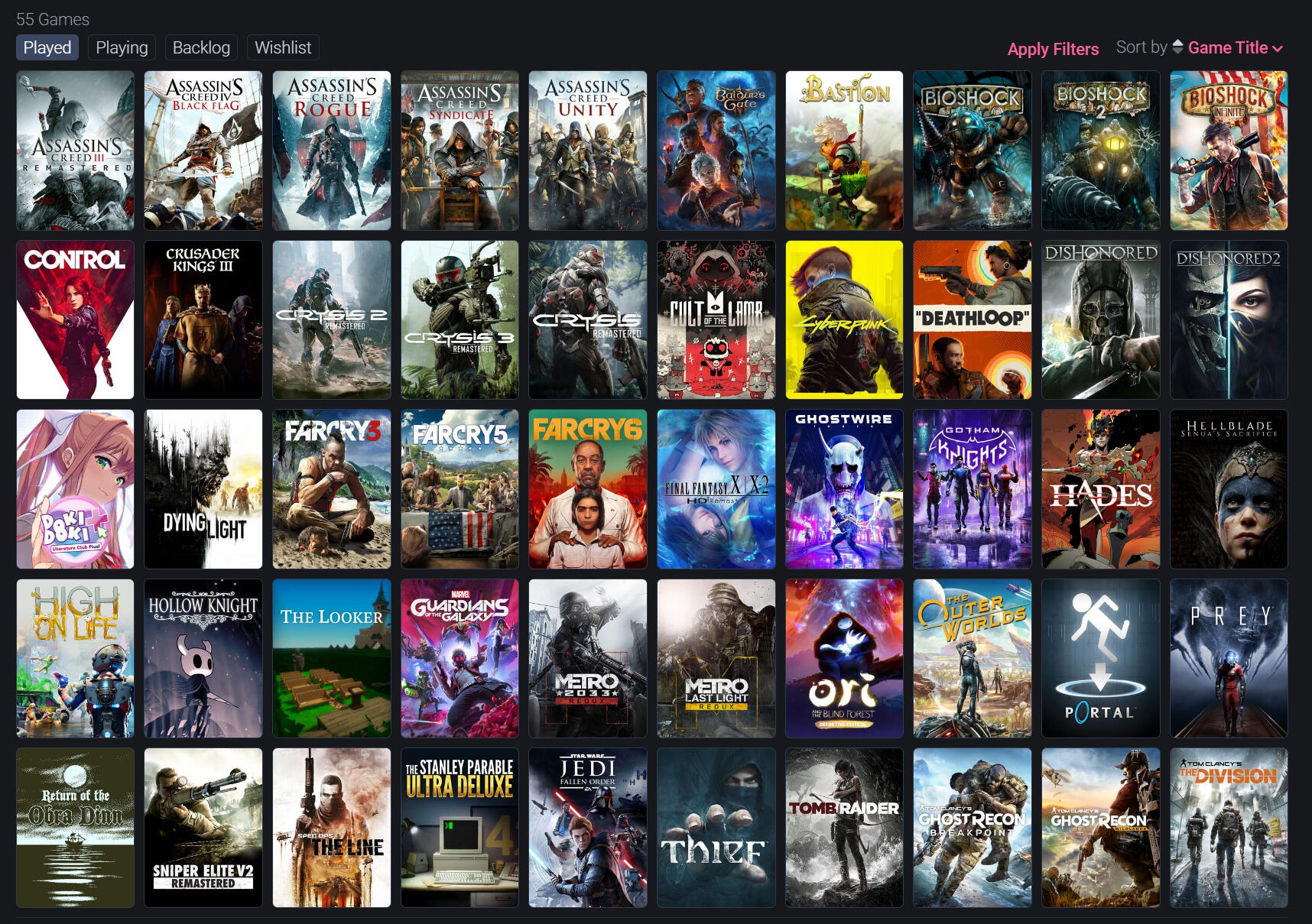
The last six months have been weird. Between my first bout of COVID, a car accident, a fried motherboard, and deciding to quit my job, I've had more trouble than normal focusing on games. Add to that the continued decline of Twitter and I've pretty much had to rethink my entire approach to recording my thoughts about games.With that in mind, I decided to finish the year with another recap of some of my most recent playthroughs. My tangible goals were practically nonexistent this time around, but the idea's to shift to handwritten journals and a six-month retrospective calendar next year.In terms of stats:
June 20, 2023 -
December 31, 2023
Played: 13
Finished: 10
Abandoned: 2
In Progress: 1
June 19, 2022 -
June 19, 2023
Played: 41
Finished: 35
Abandoned: 4
In Progress: 1
Shelved: 1
Unsurprisingly, my pace for finishing games over the last six months dropped roughly 35-40% from the prior year. Part of this, though, came down to my choice in games: I generally spent more time playing longer RPGs than shorter titles from other genres.I also tended to pick games I was more likely to enjoy this cycle; with limited time and less of a clear motive to branch out, I figured I might as well keep things simple. In the process, I found myself much quicker to jettison those that couldn't hold my attention, regardless of the exact reason.Even then, only a couple stand out as being especially painful, so I've decided to stick this time with a Top Five and Worst Two:
Top Five
Marvel's Guardians of the Galaxy
[17h 12m]
A fantastic narrative adventure with one of the greatest licensed gaming soundtracks outside of Tony Hawk's American Wasteland. Not that that's surprising -- after the success of the MCU's Guardians of the Galaxy (2014), any Guardians game worth its salt pretty much needed to have an outstanding soundtrack to succeed. Marvel's Guardians knocked it out of the park by underscoring its surprisingly realistic character arcs and bombastic narrative with fantastic song choice, stunning costume design, and genuinely enjoyable easter eggs at all points along the way. Combat could at times become slightly shallow and repetitive, but hardly enough to take away from the overarching experience -- and the "Huddle" mechanic was always more than enough to make up for it.
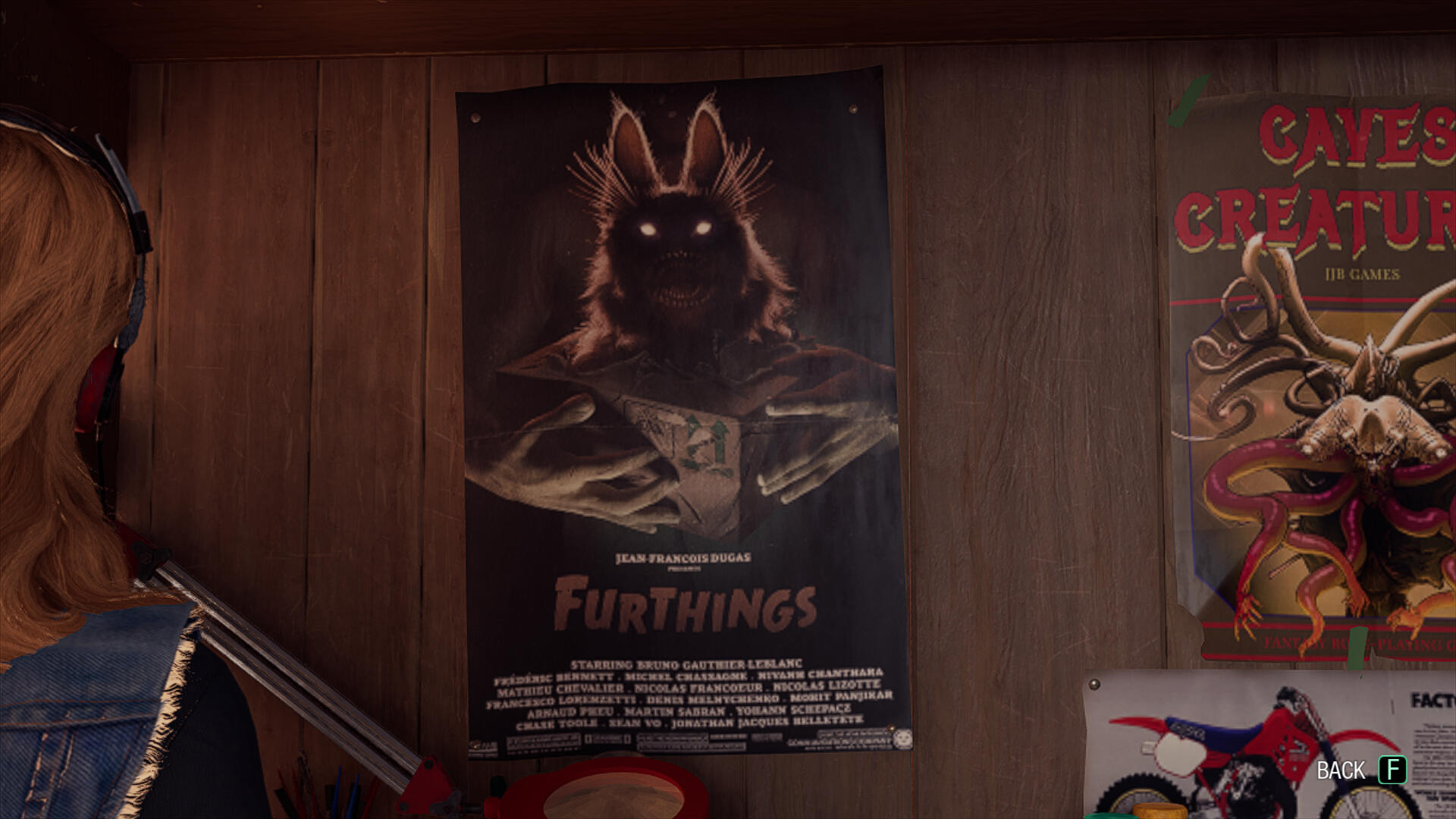
Crysis 3 Remastered
[6h 54m]
As with the BioShock trilogy, I get the sense that the "best" Crysis game is a matter of contention. I'm not quite convinced that Crysis 3 wins that competition, but something about this one stuck with me more than the rest. Maybe it's because I was finally playing as Prophet, who was basically a non-entity (sometimes literally) in the previous two, or maybe it's because it felt like it tried to tackle some of the deeper questions behind the whole series. In the end, I wanted more -- if only because I think they were on the cusp of doing something great.
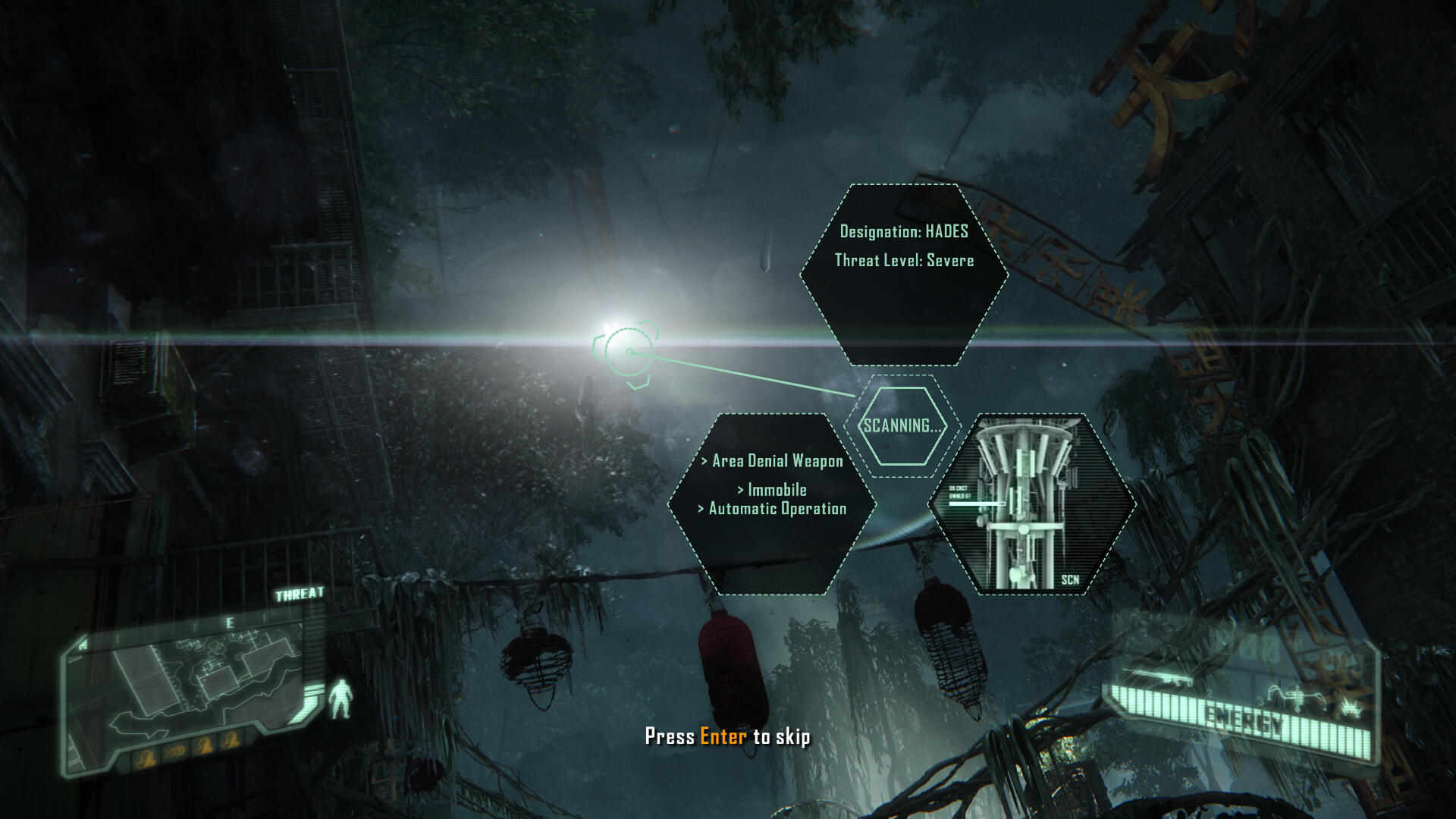
Ghostwire: Tokyo
[26h 51m]
Now one of my all-time favorite games. I let Ghostwire sit on my backlog for over a year because it ties directly to my research -- I wanted it to be good, I knew it'd feel like work, and I needed the time to really dedicate to it. And it was worth the wait. Although it does have problems, like the occasional fetch quests and semi-floaty, repetitive combat, the narrative caught me off-guard and it's been a long time since I've seen a game as well-researched when it comes to its treatment of so many smaller elements of Japanese culture. It doesn't need a sequel, but I would love to see Tango return to this world in the future.
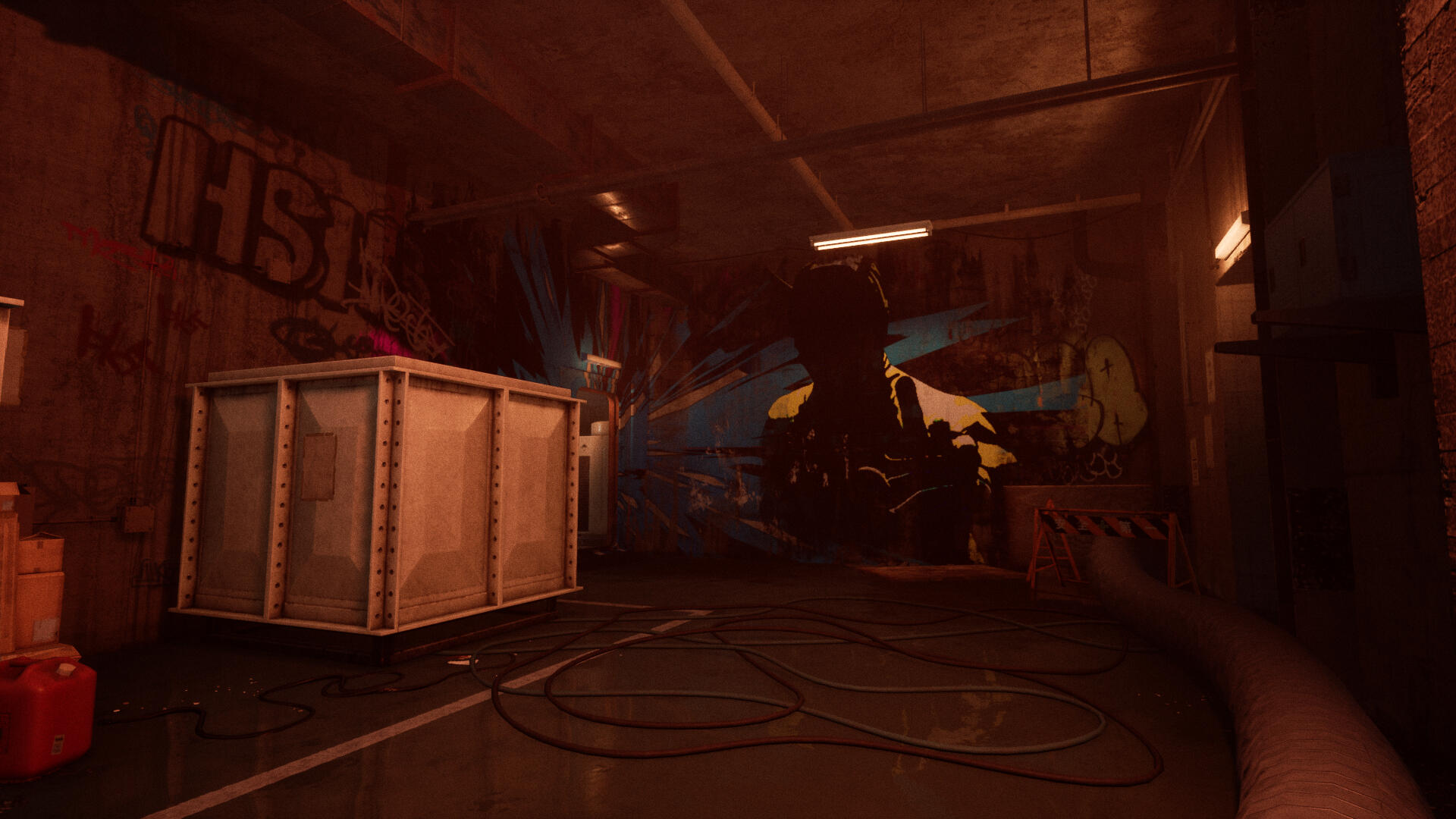
Baldur's Gate 3
[200h 48m]
The playtime alone should tell you all you need to know. To be fair, my PC did die right before I finished my first playthrough (~70hrs) -- but I still made the choice to start fresh about a month later on my backup. I've wanted to play D&D for so long, and Baldur's Gate proved more than capable of scratching that itch for me. My only regret is that they added Honor Mode right before I finished Tactician...
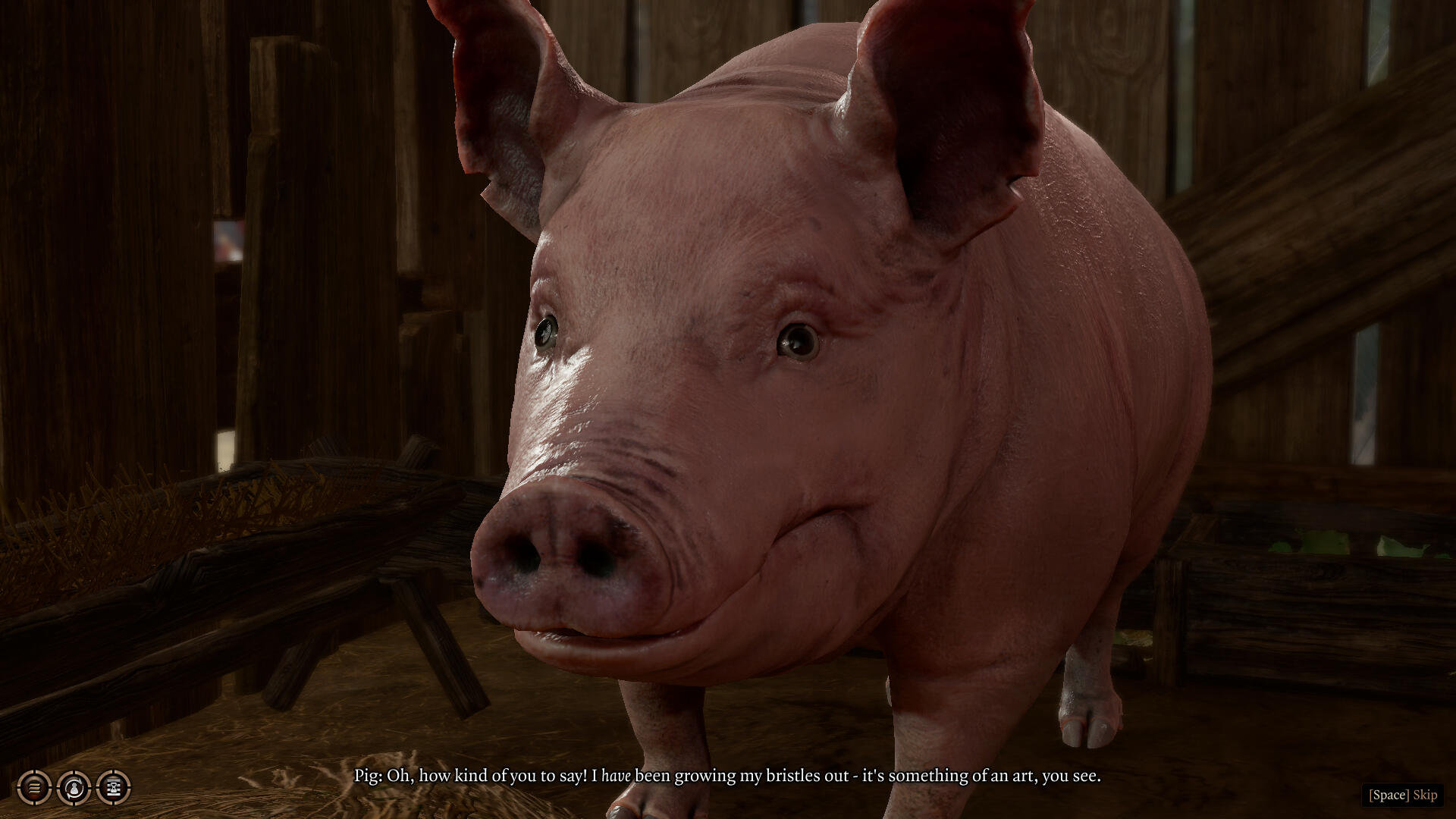
Final Fantasy X HD Remaster
[49h 20m]
One of the two JRPGs (alongside SaGa Frontier 2) that sparked my love of games as a kid. Despite all of the time I'd spent with it, though, I'd never once finished the game -- I was always too intent on trying to fully upgrade every Celestial Weapon. (I still didn't manage to do that this playthrough, but I came closer than ever!) The story stands out to me as one of the more powerful of the series, if only because I'm partial to the religious and philosophical overtones that drive the entire journey. But more than anything else, I have only two words: Sphere Grid.
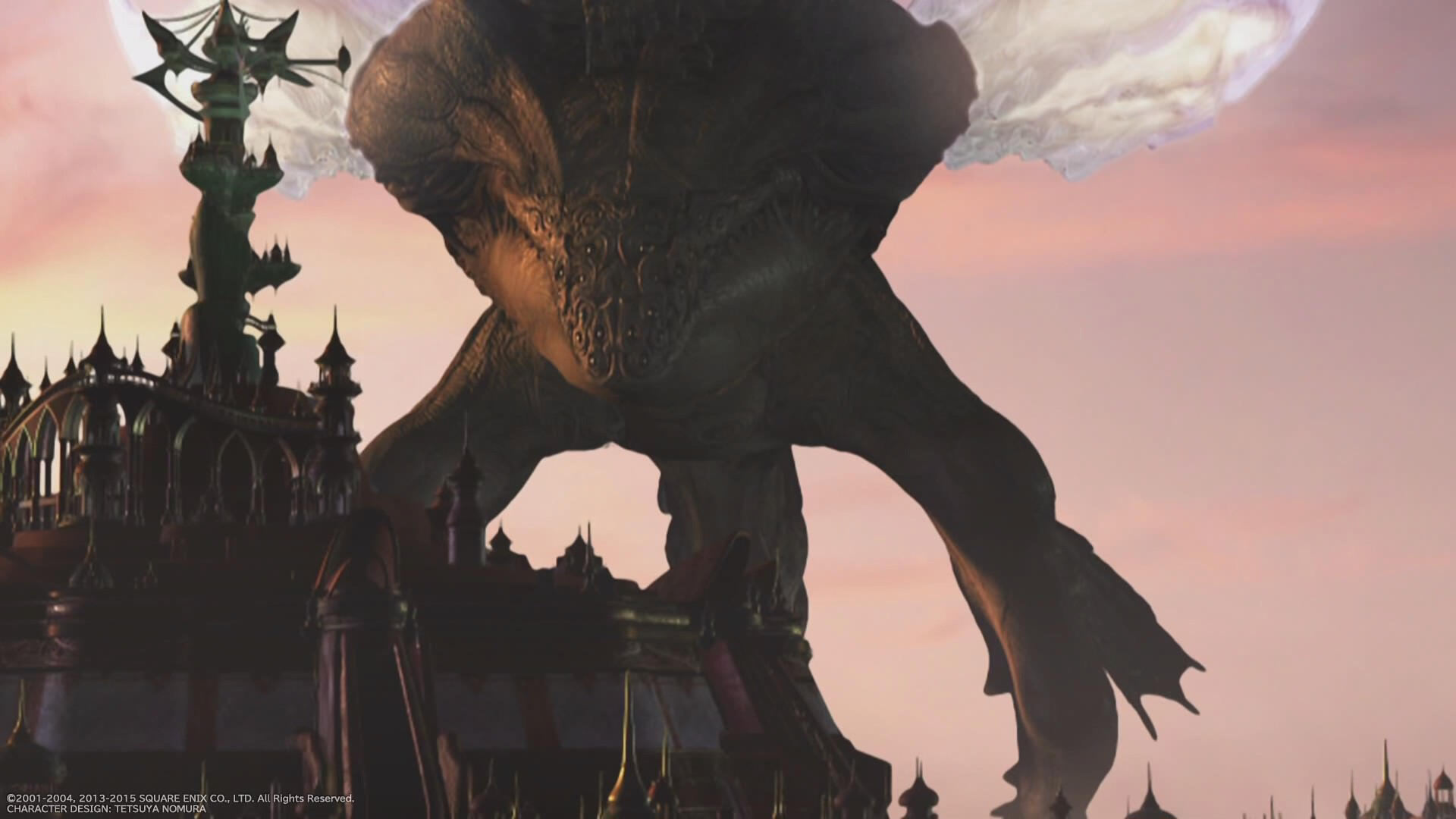
Worst Two
Disco Elysium
[4h 42m, Abandoned]
To put it bluntly: I don't think Disco Elysium is a bad game, but I'm not convinced it's as good (i.e., well-written) of a game as I'd been told. I gave this one a solid try, too -- a solid three tries, if I'm being honest. My initial problems were with the pacing, which I felt was far too slow, and the roll system, which I thought was far too punishing (damn you, Cuno!), but I didn't actually believe either were indicative of the quality of the game. I still wanted to like it, and now I'd even argue that my time with Baldur's Gate has probably better prepared me to deal with the gameplay, as a whole. That being said, I couldn't get past the dialogue options tied to each of the four political alignments, which always felt much more like a caricature of a mid-2000s Buzzfeed "Which Character Are You?" quiz than a nuanced treatment of personal ideology. I suspect there's more to it, especially given the sardonic humor that seems to characterize the broader game, and yet I have little real interest in slogging to uncover it. This one's just not for me.
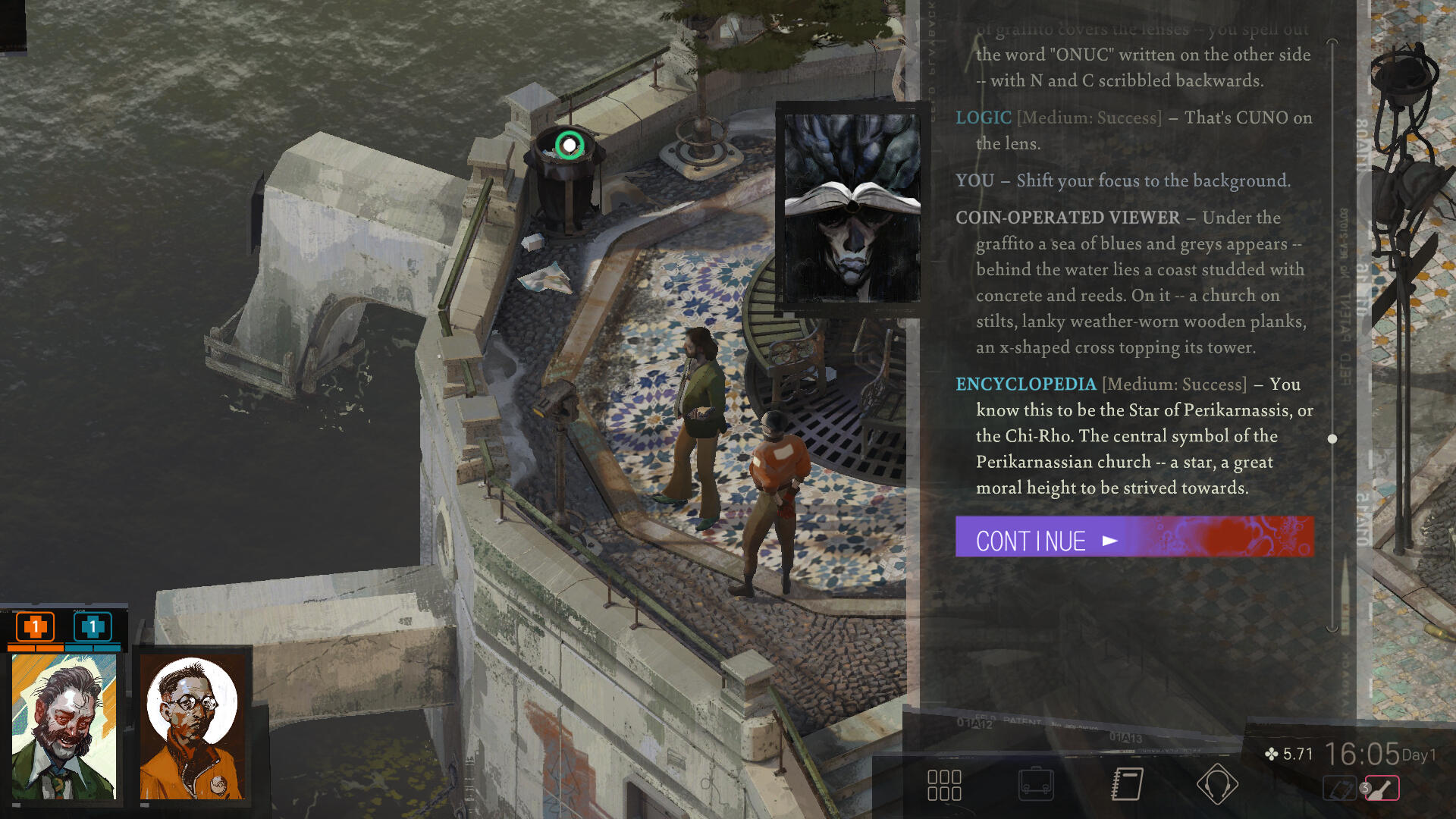
Werewolf: The Apocalypse - Earthblood
[1h 15m, Abandoned]
I downloaded Earthblood on a whim because it seemed to have a promising premise: Eco-terrorist werewolf fights corporate overlord. I've never regretted anything more in my life. Unlike Disco Elysium, it's just plain bad. The voice acting is terrible, the characters are basically lifeless dolls, and the stakes are practically nonexistent. Stealth is presented as an option (via traversal as a standard wolf), but I couldn't identify a reward for pursuing it in the early game, at least not when the faster and easier alternative is mercilessly slaughtering dozens of guards in a blood-fueled rage. I saw better endless horde-style combat in Dynasty Warriors 3.

Retrospective, Part 1

For those of you following along on Twitter, I've spent most of the last year -- from June 19, 2022 to June 19, 2023 -- playing through as many games from my backlog as possible.I had two main goals:
Pay attention to narrative.
Actually finish each game.
Easy enough, even if not entirely quantifiable -- although I did decide early to differentiate between "finishing" and "completing" (i.e., 100%) for the sake of my own sanity. I also eventually found myself paying attention to other elements like level design (e.g., Deathloop) and score (e.g., Hades, Wolfenstein: The New Order) and decided to keep those in mind as loose subsets of the first goal.And, overall, I think I was fairly successful. There were a few rough ones, most of which I'll get to below, but after years of pretty much never finishing any games, I'm pretty happy with the final stats:
Played: 41
Finished: 35
Abandoned: 4
In Progress: 1
Shelved: 1
I didn't exactly set out with the idea of doing any kind of "formal" post-mortem, but right around the halfway point, I did happen to catch Rob Mostyn's latest yearly wrap-up. I was especially fond of his concision -- something I'd do well to emulate! -- and have toyed with the idea pretty much ever since.In the interest of space, the challenge, and not completely stealing his formula, though, I've limited myself to a Top Five and Worst Three:
Top Five
BioShock Infinite
[17h 9m]
The conclusion to the series that started the entire year for me. Although I've since learned that its ranking in the trilogy is a matter of controversy, Infinite was my awakening to the potential power of narrative design. That being said, Elizabeth's arc is somewhat incomplete without Burial at Sea -- one of the few times I'd ever argue that the DLC is a necessity -- and I'm curious to know if it'll all hold up in the face of a fourth entry. I'm also willing to wager that nothing in a sequel could ever surpass the Lutece Twins, the visual nod to Le ballon rouge (1956), or the tactile pleasure of catching the coin that Elizabeth always throws to you at just the right time.
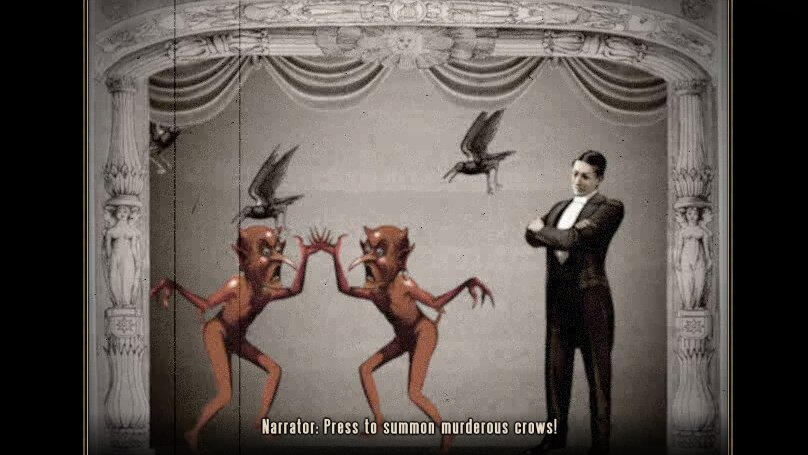
Prey (2017)
[22h 16m]
A fever dream in the best way possible. I played this immediately after finishing BioShock Infinite and it only solidified my newfound love for immersive sims. It was definitely strange to switch from such a linear experience to the relatively "open" world of Talos I, but the sheer size and verticality of some of the levels really intensified the tension and fear of being (effectively) alone: There was no shortage of hiding spots for the Typhon. In terms of high marks, the zero-gravity movement system was appropriately nausea-inducing and the found narrative collectibles were surprisingly delightful. This is absolutely one I wish I could wipe from my memory and play again from scratch.
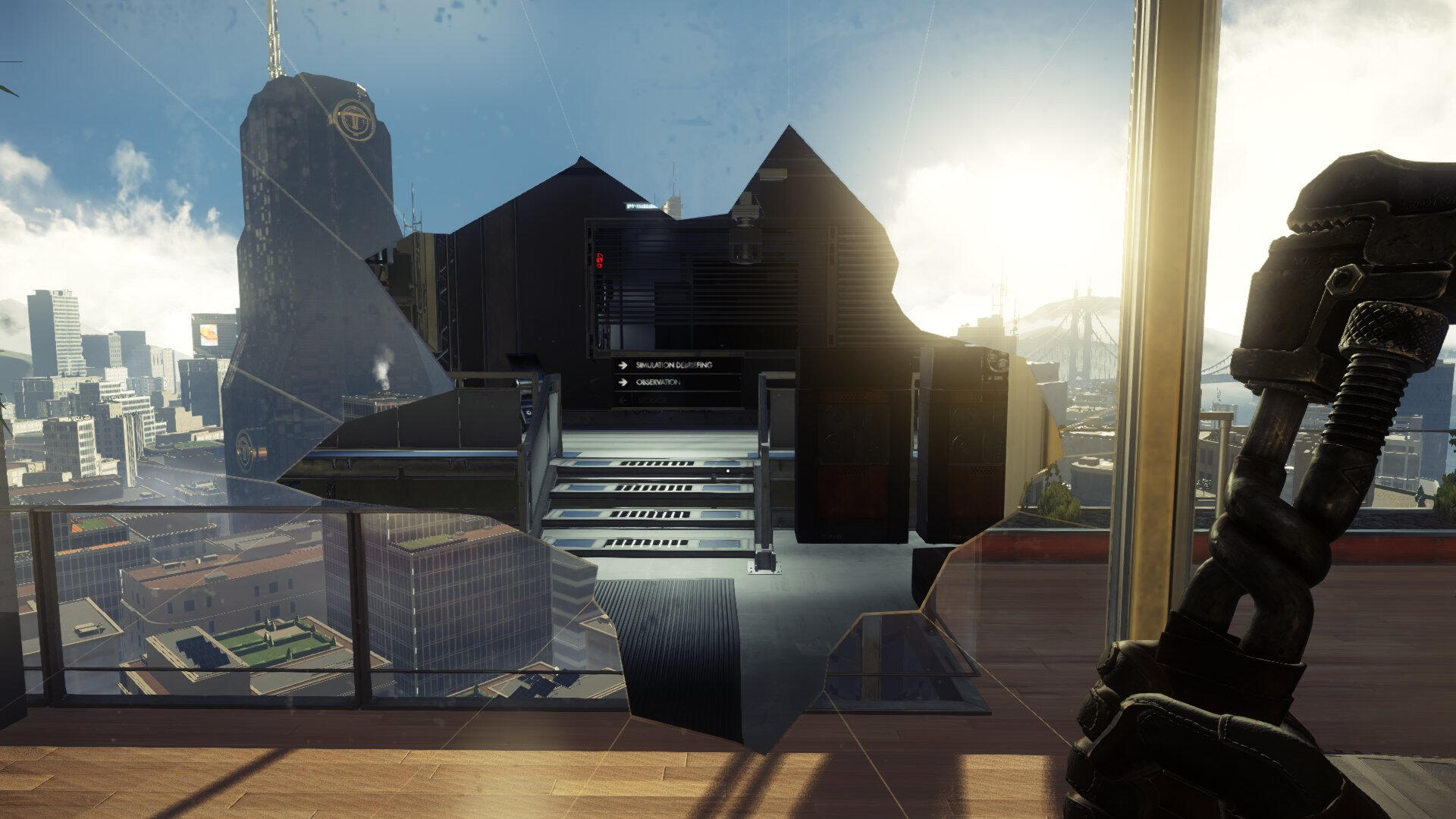
Hades
[85h 54m]
My first roguelite. I had low expectations for this game because I knew next to nothing about it -- or the genre -- but it didn't take very long to hook me at all. And while the combat was undoubtedly a fantastic selling point, I think I was even more invested in the piecemeal structure of the narrative. (It must've been 60-70h before I finally figured out the name of the warrior shade in Elysium!) At the end of the day, it's a simple and old story at its core, but I'm still extremely impressed by the extent to which Supergiant was able to revitalize it for a modern audience. Let's not talk about the fact that I put more than three days into it, though.
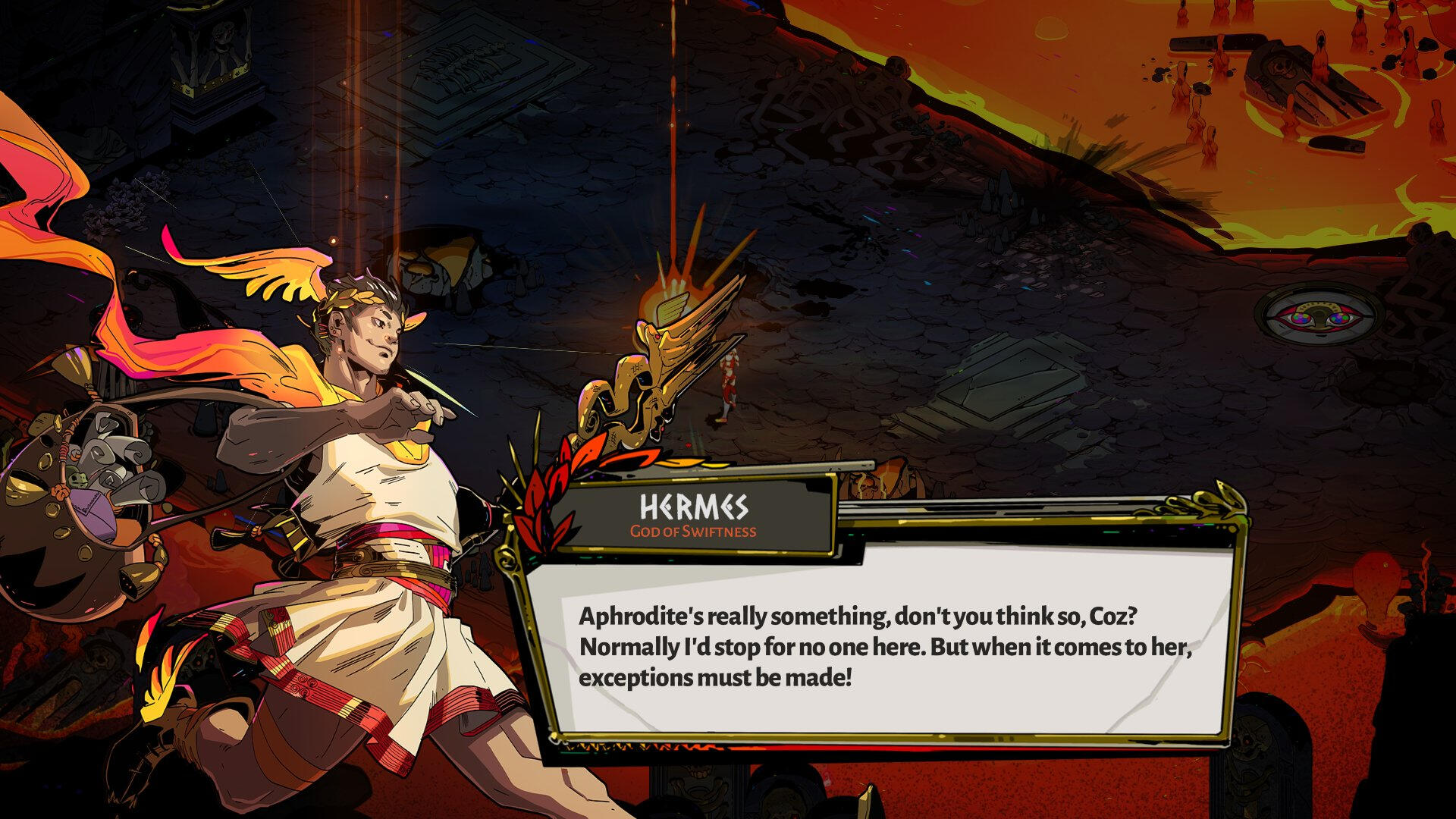
Wolfenstein: The New Order
[10h 12m]
Wolfenstein absolutely blindsided me. I played this after The Old Blood, so technically out of release order, and I'm so grateful I did: Where The Old Blood is irreverent and superficial, The New Order is lovingly crafted and deeply moving. It doesn't shy away from the ridiculosity of its predecessors, but it also never takes its own hypermasculinity too seriously. In fact, I said it at the time on Twitter, but it bears repeating that Ramona's diary is an example of found narrative done right -- and its introduction near the end of the game only further reinforces the weight of everything you've seen up to that point. If I could forever teach one game to student developers, it'd be this one.
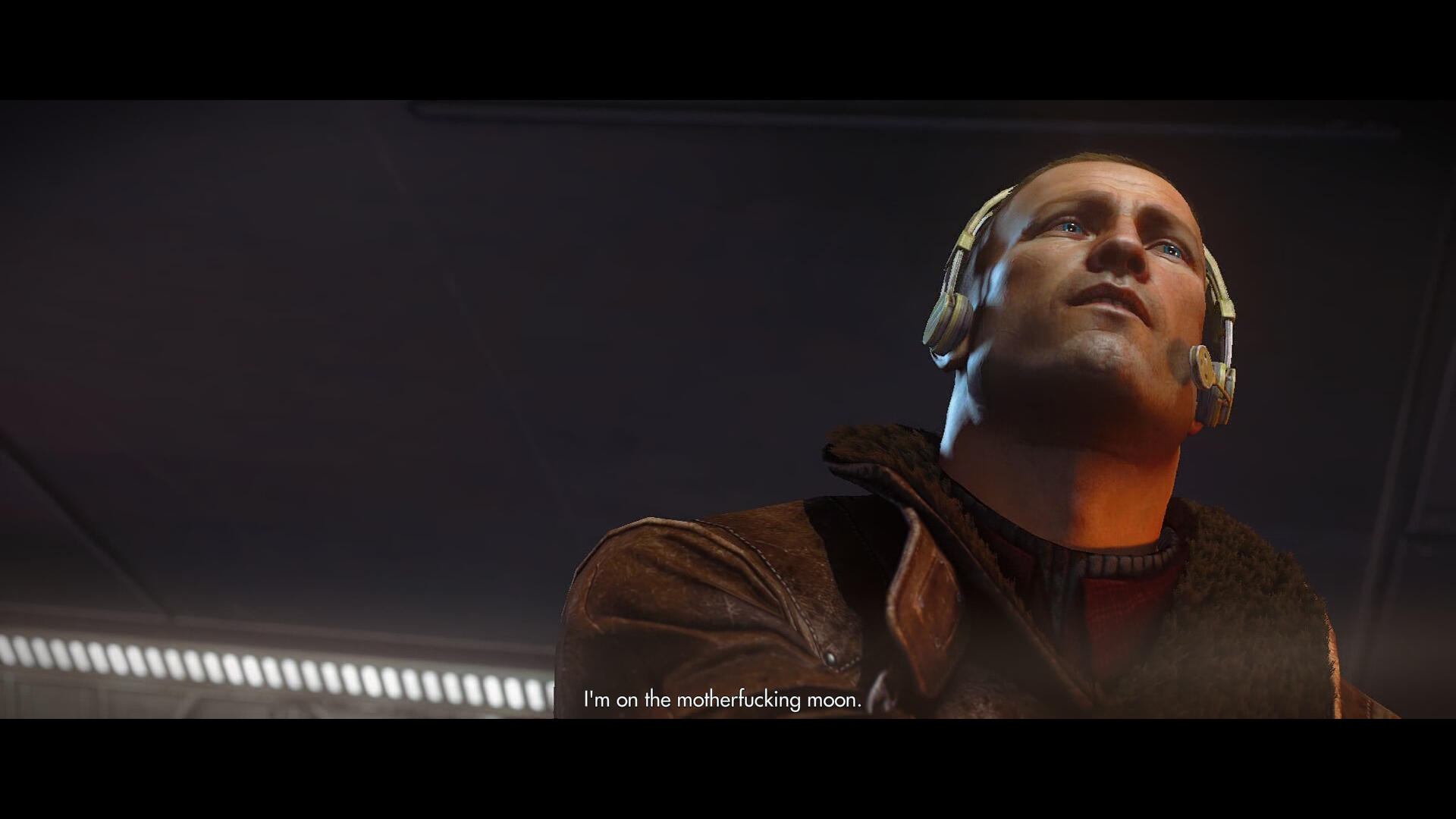
Hollow Knight
[26h 22m]
My second metroidvania after Ori and the Blind Forest, which I found rewarding to finish but infuriating to play. Hollow Knight had a much shallower learning curve, even if it did eventually take significant practice to down some of the mid- to late-game bosses. I briefly uninstalled near the end of the game -- mostly out of sheer boredom from my inability to make any progress -- but I couldn't let it go after about a week. Something about playing as a creepy-cute little bug steadily gaining power in a dead world appealed to me, I guess.
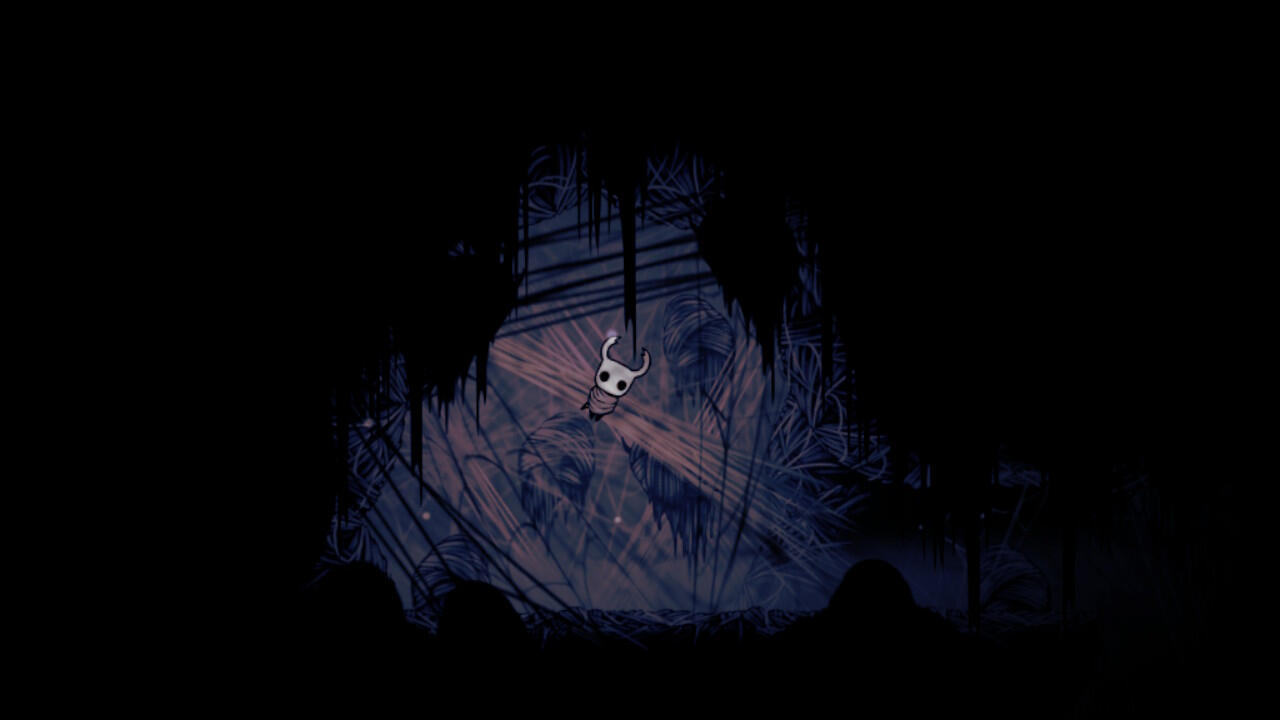
Worst Three
Gotham Knights
[20h 48m, Abandoned]
I'm actually sad about this one. I wanted to like it. After weeks of negative reviews, I thought they had to be overblown -- and even now I'm convinced that I was at least half-right. As I see it, Gotham Knights was clearly meant to be a "live service" game, but it never found its footing. Although I was especially fond of the characters (and stuck to Jason Todd / Red Hood my entire playthrough), the repetitive side quests and monotony of the core loop, coupled with the burden of managing a gear score, took away from the entire experience. Even so, I was able to put up with it until one of the very last missions, which tasks the player with hunting three mini-boss-like Man-Bats in a single night. In the midst of my mad rush to the endgame, I'd largely neglected gear score without any real repercussions -- but here it caught up with me, halted any forward momentum I'd gathered, and completely shattered the pacing of the final act.

Thief (2014)
[10h 28m, Abandoned]
Thief was guilty of a similar crime, albeit in a slightly different way. By the time I'd abandoned Gotham Knights, I'd reached my last few missions with Garrett and, once again, thought I could push my way to the end. I completely hit a wall in the second-to-last boss fight: Set in a closed circular arena-like space, it forces the player into a direct, unavoidable conflict with the opponent at hand. I'd enjoyed much of the level design and gameplay to this point, but the very existence and structure of the battle immediately undermines the "freedom" of choice offered to players from the start. It just felt wrong on all counts.

Jedi: Fallen Order
[Approx. 3-4h, Abandoned]
I wanted to like this one a bit less than the previous two, but I was excited at the start. I'm not a fan of Star Wars, so I thought this might be the one that would really pull me into the world -- and, again, it almost succeeded. After a few hours, though, I had to give it up because I just hated the platforming elements and puzzle design. I think both are incongruous with the setting, and I'm not convinced they added anything to the experience. The combat was phenomenal and the story seemed extremely promising, but I didn't have nearly enough stamina to slog through the levels themselves to get anywhere meaningful.
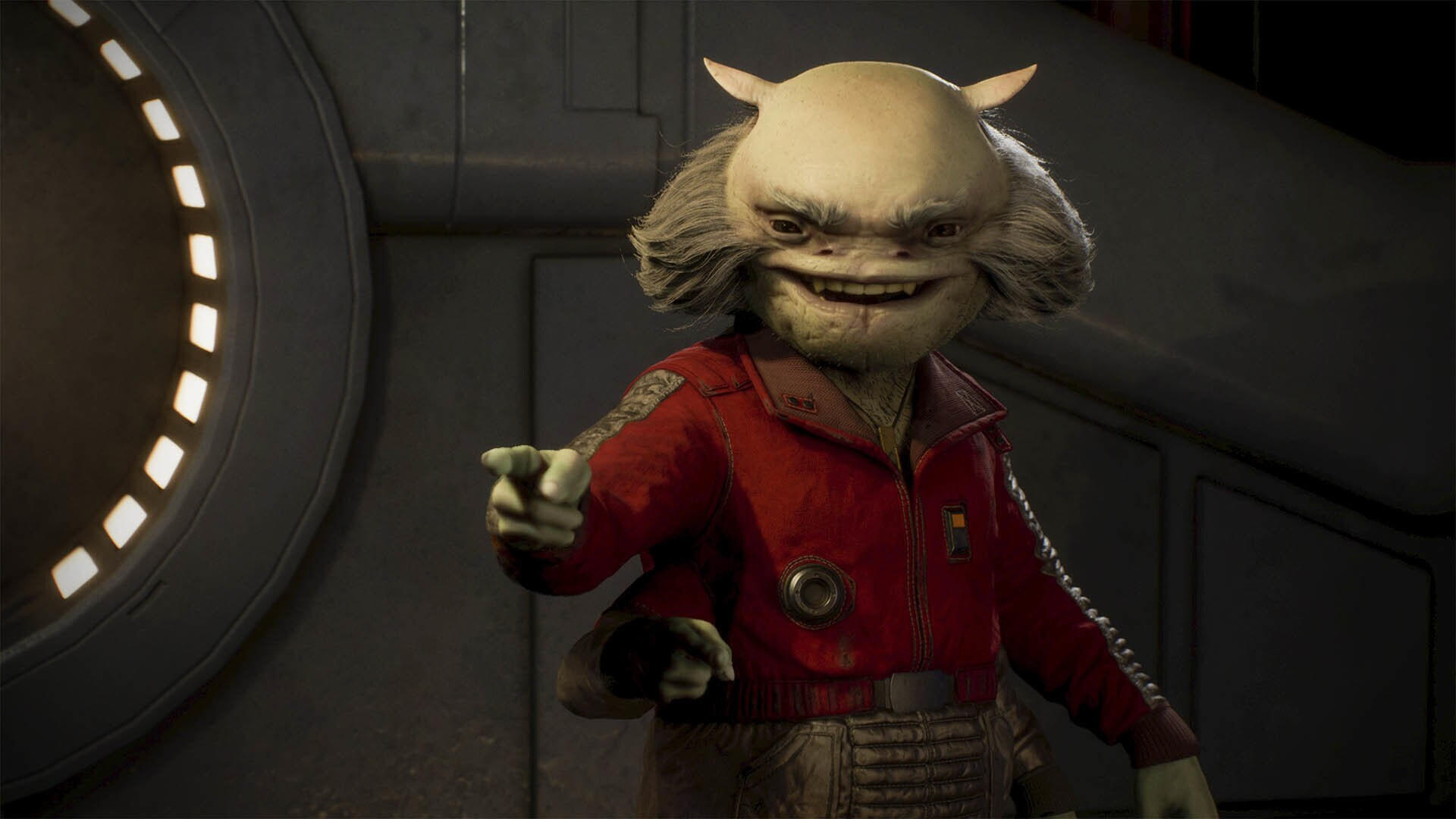
Demon Hunters and Candle Thieves
[Retrospective: Placeholder.]
It turns out the hardest part of getting back into Warcraft is starting a new character.Not deciding on one. That's easy enough for me -- I always stick with Night or Blood Elves and typically default to DPS before anything else. (This time around, I'm going Alliance and running with a Night Elf Demon Hunter named Tetsuri.)No, my real problem, I think, seems to be with the story and power progression at lower levels.You've probably heard or thought about this before, too. It was one thing back in Vanilla or The Burning Crusade when you'd level your character and throw down with Onyxia or Kael'thas. Even Arthas and Deathwing weren't that much different as "big bads" in Wrath of the Lich King or Cataclysm. But now, the stakes have become increasingly absurd -- as have the power differentials between new and veteran characters, level squish be damned.And in the case of a Demon Hunter, the narrative disconnect is particularly jarring.After all, they have a long history. You can't really understand a Demon Hunter without knowing at least something about Illidan, the Burning Legion, the Well of Eternity, or other large swathes of in-universe backstory, all of which date back beyond The Burning Crusade and Warcraft III. Maybe you pick one for the glowing eyes or glaives, sure, but the glowing eyes and glaives are themselves part of the lore of the class.
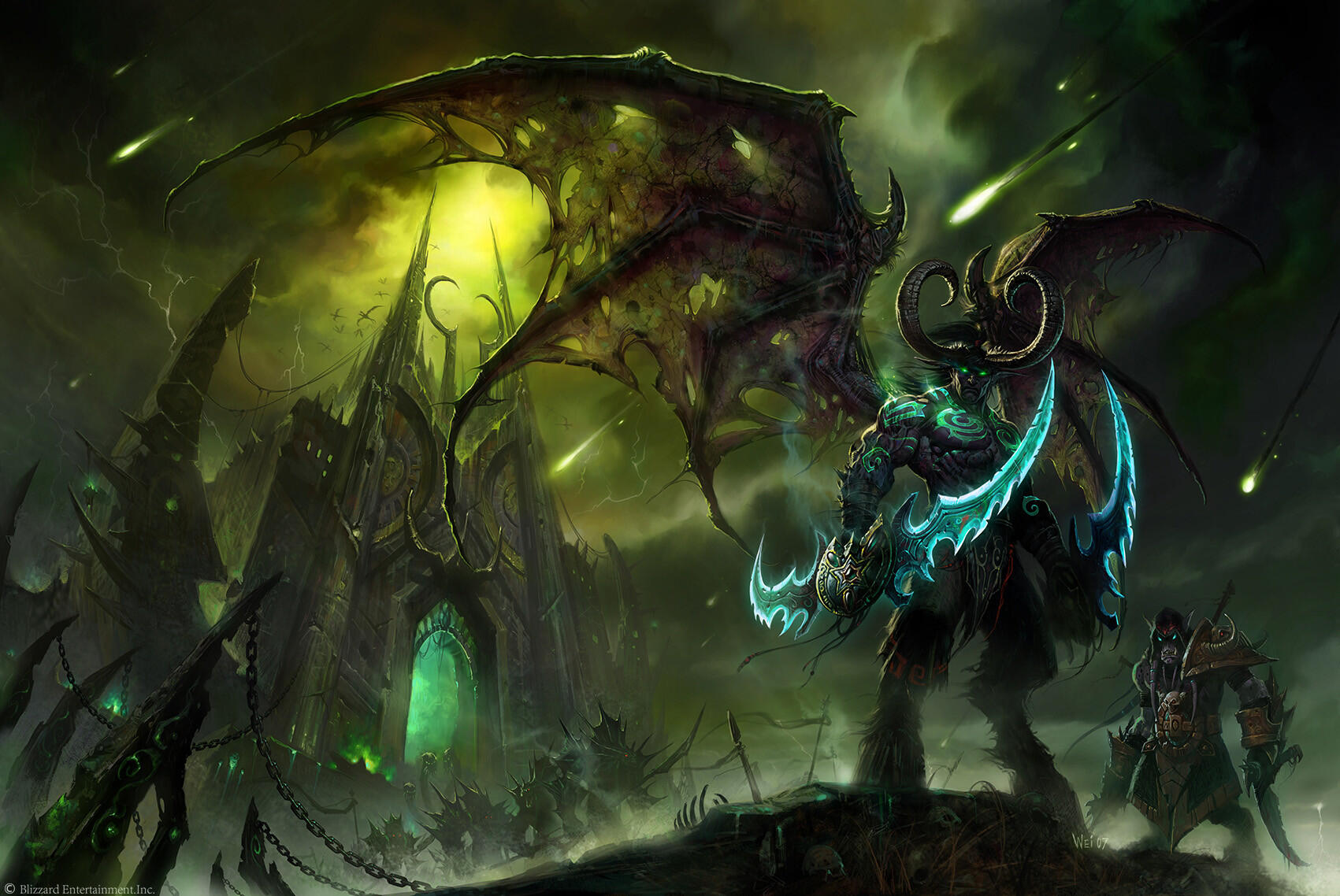
Nor were things made any easier by the real-world production schedule. When Blizzard announced that they'd introduce the first hero class, the Death Knight, in Wrath (2008), players immediately began to speculate about potential future additions. The Demon Hunter was an obvious one, not least because of the depth of the aforementioned lore -- and yet it wasn't for another eight years that Blizzard finally sent them live.So, when you decide to roll a Demon Hunter, you're rolling a character that has a bit more depth than any other amateur Hunter, for example, and you expect Big Things.And Blizzard delivers for the most part. The introductory questline for Demon Hunters puts you amongst the ranks of Illidan's army years before his defeat in The Burning Crusade. You fight some demons, find yourself imprisoned, and then join forces with your captors to fight some more demons. Maybe not Big Things, but not too far off.The issue is that when you're dropped into Stormwind to join the Alliance (in my case), you're dropped back into a world in which the most dangerous things around are wolves, a boar named Princess, and rat-men with a strange affinity for candle hats.It's perfect for a fresh-faced adventurer. The stakes are much lower, if they even exist at all, and quests are a matter of harvesting wolf pelts or delivering meat pies or love potions. Dragons and world-ending plots don't have a place here. Unfortunately, the same can be said for battle-hardened demon slayers.Somewhere along the developmental highway, they got left behind -- or, more accurately, were overlooked and never fully reconciled with the layers of narrative worldbuilding. Demon Hunters might work well in Legion when the fate of Azeroth depends on their cooperation, but they don't need tutorial questlines anymore. They farmed their own wolf pelts and moved on long ago.

To be fair, though, all of this is a problem of my own making. I could pick a different timeline and level up there instead, maybe exchanging the rat-men for snake-men or dragon-men in the process. And there's definitely nothing stopping me from just playing through Legion and continuing to fight demons until I get "back up to speed."But then that raises another question: Without player choice, does narrative continuity still actually mean anything? Or does it matter at all?You see, here's the thing: When I was kid, I loved Elwynn Forest. It was absurd. I hated the human character designs, but I loved their starting area. No matter which other race I rolled, I'd run to Elwynn Forest just for the sake of spending the first few starting levels there.Almost twenty years after launch, I still want to do the same thing. It's the nostalgia factor. I want to try to remember things I'd forgotten, or uncover something new I've overlooked over the years. If I have to give that up just to have a coherent narrative (i.e., a linear progression in strength and development that leads me to stronger enemies), I'm not entirely sure it's worth it.And so I'm seemingly stuck without a viable solution. On the one hand, I ignore the underlying story for a trip down memory lane. On the other hand, I give up the past in an attempt to follow a semi-cohesive thread into the future. The Demon Hunter doesn't get to have it both ways, at least not without abandoning the narratives that birthed it in the first place.Until that changes, I guess I'll just keep killing kobolds and taking their fucking candles.
Subverting Chanbara: The Case of Samurai Champloo, Part 3
[Continued from Part 2!]
As a final note, we have to acknowledge that neither Mugen nor Jin are unique in their subversion of chanbara tropes. Although they — and their battles — are ostensibly the focal points of the series, the two are surrounded by a rotating cast of characters whose actions and/or words continually highlight the complex nature of human morality.In one episode, for example, random villagers and soldiers believe the giant, disfigured Oniwakamaru to be an ogre, yet he ultimately saves Fuu by crushing the neck of her captor and would-be assassin. On another occasion, we learn that the Kawara Yakuza is led by Heitaro the Buddha, a middle-aged man who refused to disband the group lest “the [local] youngsters” lose the only place they could call home. Later still, a young man named Shinsuke fences opium to buy medicine for his terminally ill mother; the Niwa Brothers appear to be little more than thugs, at least until they inform Jin that they want to graffiti Hiroshima Castle as vengeance for their father’s disgrace and suicide; and Sara, a blind goze who travels with the trio for some time, reveals herself to be a skilled assassin, but admits that she was forced to take her most recent contract in order to see her son.Each of these cases serves to undermine the oversimplified moral narratives that characterize (Japanese) melodrama — and the melodramatic chanbara, by extension. The heroes are not always heroic, and the villains are not always villainous; rather, they exist somewhere in the middle by the end of the tale. At the same time, the series leaves us with only questions about the validity of “good” and “evil” because it never attempts to provide any answers to their moral dilemmas: Oniwakamaru and Sara allow Mugen to cut them down, Shinsuke dies at the hands of local guardsmen, and Heitaro takes his own life to save his son. None are given the opportunity to experience any real character development, and none are forced to face the long-term repercussions of their negative actions.But this is intentional. All are merely brief encounters on a much longer journey to find the Sunflower Samurai. They are side characters, literally and figuratively, but their actions show that honor, courage, and benevolence are never limited to the samurai alone.Historical characters undergo a similar type of treatment. Whereas the aforementioned criminals actively subvert audience expectations by showing that they are capable of goodness, the series takes extensive liberties with its portrayals of real-world figures to passively illustrate the limits of reality over fiction. Thus, an ukiyo-e artist named Hishikawa creates a print of Fuu that finds its way to Holland and inspires Vincent Van Gogh’s Sunflowers; Isaac Titsingh, Governor General of the Dutch East India Company (VOC), inadvertently falls in love with a male kabuki actor before revealing that it is “even better” because he is actually gay; and Jin is nursed back to health by a red-haired, gap-toothed, half-crazy hermit who claims to be the legendary Miyamoto Musashi.All are meant to be read as lighthearted instances of artistic license because they seem so absurd. However, the world of Samurai Champloo is a world in which tradition and modernity are connected and good and evil exist within a single individual — in other words, it is a world not entirely unlike our own. The “fictional” idea of a red-haired Musashi is therefore implied to be hardly any more absurd than the “real” legends that surround his swordsmanship, and hardly any less difficult to verify. Here, then, the series undermines its roots in chanbara by problematizing the super-reality of melodrama. It reminds us that the idealized past, a past that supposedly produced legendary swordsmen, might have not been so ideal after all.But aside from Mugen or Jin, no single secondary character better embodies the inverted expectations of history, reality, and morality than Heike Shige. As his name suggests, Shige claims descent from the Heike / Taira Clan of Heian Japan, one of the most prominent side branches of the early modern imperial line. Mugen, Jin, and Fuu encounter Shige in a crater-turned-excavation site, which he insists is home to the treasure of the Heike and the key to his goal of overthrowing the shogunate. He tells the trio that he and his workers have been searching for the treasure for five years, but Fuu soon discovers that the target of his ire is the Kamakura Shogunate — and not the Tokugawa. At the same time, she realizes that his workers seem to subsist on wasabi root alone, and appear to have the ability to recover from gruesome bodily harm.She confronts Shige to inform him that he has actually been digging for five hundred years, but he refuses to listen; instead, he responds by resurrecting dozens of his deceased workers and threatening to add her to their numbers. Fuu is only saved when a weakened Jin reveals that the genealogical scroll Shige keeps with him is actually incomplete: There is a clear break between his own name and those of his Heike ancestors. When the zombies turn toward Shige, furious that they have wasted their (after)lives, he strums his biwa; turns his head toward the sky; exclaims, “Thank you for watching!”; and summons a meteor onto the dig site. The episode ends with a shot of Ogami Ittō and Daigorō (of Koike Kazuo’s Lone Wolf and Cub) observing the resulting mushroom cloud from afar.Casual observers treat the tale of Shige as pseudo-filler, a deviation from the main plot that serves only to underscore Watanabe’s flippant attitude toward history (and passion for zombie flicks). For them, it is simply the “bizarre” zombie episode. The problem with these descriptions is that they necessarily fail to acknowledge the ways in which Shige mirrors both Mugen and Jin. His intentions are, after all, noble: He aims to restore the Heike to their former glory by overthrowing the “usurping” Kamakura. The plan itself is a romantic one, but it turns tragic as Shige loses track of time — and loses his own humanity — in the process. Meanwhile, this stoppage of time leads to a conflation of tradition and modernity that manifests through Shige’s own body. He is simultaneously young and old, alive and dead, a relic of the past unable to live within the present. And when he learns that he is not a true Heike, he breaks the fourth wall to address the audience directly. In that moment, the line between reality and fiction collapses, and the entire narrative falls apart as even the primary trio seems to be caught in the meteor’s path.But Mugen, Jin, and Fuu all return in the next episode, the beginning of the series’ final arc. Shige and his zombies thus subvert our expectations of not only history, reality, and morality, but also the structure of a standard narrative. The conclusion is not a conclusion, despite its atomic implications, and the heroes live to journey onward another day. More importantly, Shige illustrates the extremes of a “fanatic” devotion to the past (Jin) and “criminal” life without thought in the present (Mugen). Neither is tenable in the end, but both are ultimately capable of mediating the other.

Concluding Thoughts
On a panel in February 2006, Watanabe Shinichirō gave a list of Samurai Champloo’s cinematic influences. Among them were Bruce Lee’s Enter the Dragon (1973), Don Siegel’s Dirty Harry (1971), and a Japanese character named Zatoichi, the focus of a television series (1974-1979) and more than two-dozen films (1962-1989, 2003). Unlike his chanbara predecessors, Zatoichi is blind, yet still capable of wielding two blades (or a blade and scabbard) simultaneously and to deadly effect. The character is also known in part for his checkered past, one for which he attempts to atone through his present actions. Even so, he remains a perpetual outsider, a wanderer incapable of fitting into society and consequently forced to survive on its literal and figurative borders.Similar themes of inverted expectations, moral complexity, and liminality permeate the entirety of Samurai Champloo. As we have seen, neither Mugen nor Jin fit the stereotype of Ryukyuan criminal or noble samurai; rather, both characters subvert popular assumptions about their respective roles by embodying characteristics of their counterpart. Mugen thus exhibits an amorphous code of honor at least somewhat reminiscent of bushidō, while Jin struggles with the notion of loyalty and the need to subordinate himself to a lord. And in the process, they each come to embody and undermine a series of binaries — tradition and modernity, good and evil, Japanese and non-Japanese (Ryukyuan) — that are themselves derived from historical manifestations of chanbara and bushidō.

Additional Reading
[Note: As with other academic papers posted here, I've removed footnotes to ease the experience of reading in a web browser. This means that paraphrased or summarized material is not always explicitly attributed, particularly in the introductory "lit review" in Part 1. My writing is heavily indebted to each of the authors below, academic or otherwise, and I am always happy to provide additional citations from my original paper as necessary.]
“Episode 22 - Cosmic Collisions.” Amalgam: A Samurai Champloo Fansite. Accessed 24 April 2020.“Shinichiro Watanabe at Detroit Film Theatre, Feb. 8th, 2006.” Amalgam: A Samurai Champloo Fansite. Accessed 24 April 2020.“The Complete Guide to Anachronisms in Samurai Champloo - Cosmic Collisions.” Amalgam: A Samurai Champloo Fansite. Accessed 24 April 2020.blautoothdmand. “Samurai Champloo: Anachronisms, counterculturalism, and going against the grain.” Wordpress. Published 16 April 2016.drealyn22. “Untitled Response to Anonymous Question.” Tumblr. Published 14 July 2017.onereadleaf. “Samurai Champloo: Creative, Cynical History.” Wordpress. Published 18 February 2013.Benzon, William L. “Postmodern is Old Hat: Samurai Champloo.” Mechademia: Second Arc, Vol. 3 (2008): 271-274.Bolton, Christopher. Interpreting Anime. Minneapolis, MN: University of Minnesota Press, 2018.Coates, Jennifer. Making Icons: Repetition and the Female Image in Japanese Cinema 1945-1964. Hong Kong, PRC: Hong Kong University Press, 2016.Davis, Darrell William. Picturing Japaneseness: Monumental Style, National Identity, Japanese Film. New York, NY: Columbia University Press, 1996.DeHart, Jonathan. “Forbidden Ink: Japan’s Contentious Tattoo Heritage.” The Diplomat. Published 4 October 2016.Figal, Gerald. Civilization and Monsters: Spirits of Modernity in Meiji Japan. Durham, NC: Duke University Press, 1999.Harootunian, Harry. “‘Detour to the East’: Noel Burch and the Task of Japanese Film.” In Noël Burch, To the Distant Observer: Form and Meaning in the Japanese Cinema, ed. Annette Michelson. Berkeley, CA: University of California Press, 1979.Kearns, Angel. “Inked and Exiled: A History of Tattooing in Japan.” Bodylore. Accessed 15 April 2020.Rabson, Steve. The Okinawa Diaspora in Japan: Crossing the Borders Within. Honolulu, HI: University of Hawai’i Press, 2012.Park, Macy. “Anachronistic Anarchy: A Linguistic Character Analysis of Shinichiro Watanabe’s Samurai Champloo.” The Eagle Feather. Accessed 24 April 2020.Siniawer, Eiko Maruko. Ruffians, Yakuza, Nationalists: The Violent Politics of Modern Japan,1860-1960. Ithaca, NY: Cornell University Press, 2008.Yoshimoto, Mitsuhiro. “Logic of Sentiment: The Postwar Japanese Cinema and Questions of Modernity.” Ph.D. Dissertation: University of California, San Diego, 1993. ProQuest ID: 9330404.
Subverting Chanbara: The Case of Samurai Champloo, Part 2
[Continued from Part 1!]
The following sections seek to combine these three discourses — of a transformative continuity between tradition and modernity, vernacular modernism in melodramatic chanbara, and rapid oscillation from identification to alienation — through a focus upon Mugen, Jin, and a conglomerate of secondary antagonists and side characters. In doing so, I intentionally position myself against popular interpretations of Samurai Champloo in the American context, many of which emphasize themes of difference and historical irreverence. For instance, Macy Park argues that Mugen, Jin, and Fuu are “undeniably different in their respective roles,” and “each represent an aspect of Watanabe’s ideal social champloo.” A blogger named onereadleaf admits that the series is a “dialogue with history,” but almost immediately afterward insists that it has a “sense of irreverence and an unwillingness to take itself seriously.” And William Benzon, author of one of the very few academic articles on the series, proposes that it “goes beyond subverting postmodern interventions into culture, identity, [and] antihegemonic subalterns” by “rendering such critical expostulation irrelevant.”As I see it, all three authors, and the broader body of work that they represent, singularly fail to consider Samurai Champloo as a product of Japanese history, society, and even the mind of its creator, Shinichirō Watanabe. We will see below that difference is superficial, especially in the case of the relationship between Mugen and Jin, and that tradition and modernity are really not that far removed from one another. At the same time, I show that the series’ lighthearted approach to history is indicative of Watanabe’s own awareness of cinematic and moral expectations tied to chanbara film. Samurai Champloo is thus far from “irreverent,” not least because the term necessarily implies a lack of respect for its subject. Watanabe may intentionally subvert the norms of the melodramatic chanbara, but he never loses sight of the past and those to whom he is indebted.
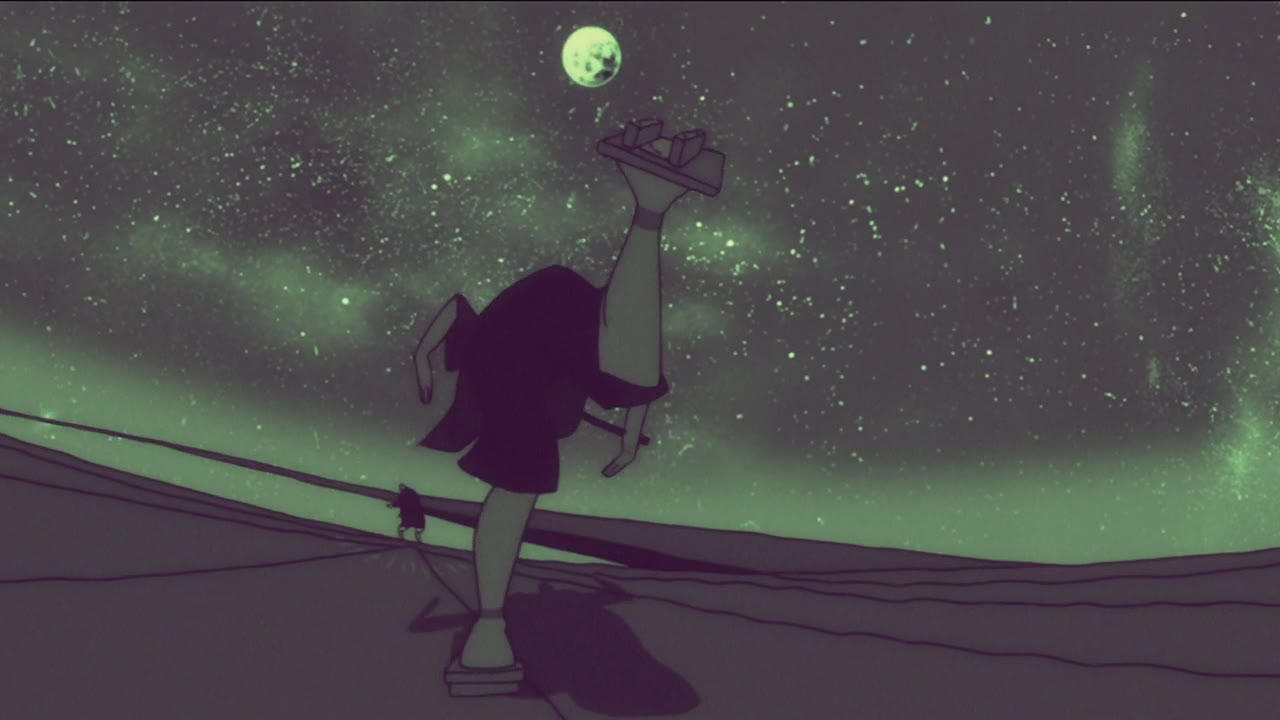
Mugen: The Ryukyuan Criminal
Mugen is intentionally constructed as a rebellious antihero. He first appears in shackles alongside Jin, calmly awaiting his execution at the hands of a corrupt prefectural governor. When asked for his final words, he sneers and says that “if living means bowing down to the likes of you bastards, then I’ll die on my feet with my head held high.” He echoes this sentiment in a flashback to an earlier encounter with the governor’s son. The latter, a corrupt thug himself, refuses to believe that Mugen would defy him; as he puts it, the Warring States period (Sengoku jidai) is over and “folks swinging swords are anachronistic.” Mugen responds with a simple proclamation: “Your common sense doesn’t mean jack to me. I hail from the Ryukyu Islands.”We see the implications of this attitude throughout the remainder of the series. Most obviously, Mugen looks the part of the freewheeling vagabond. His hair is unkempt, he sports a short goatee, wears simple blue earrings, and has blue bands tattooed around each of his wrists and ankles. Unlike Jin, he prefers a loose, unbelted happi-style jacket and shorts, as well as metal-soled geta that he employs in battle. Mugen also carries his sword, which itself has a curved blade and pronged tsuba, in a patterned sash around his right shoulder; as a last resort, he secrets a shorter tantō at the small of his back.Mugen’s actions consistently reflect a similar lack of refinement and inclination toward immorality. Although the entire trio often finds itself perched on the brink of starvation, only Mugen allows his appetites to override any semblance of self-preservation or restraint. He eats crabs like apples, apparently swallowing the entire shell; consumes unknown mushrooms picked from a forest floor; steals food from the table of the Nagatomi Yakuza; and mugs members of another yakuza group for ferry money, only to spend it instead on an abundance of squid. And these appetites extend beyond food, as well. When Fuu falls asleep after drinking in the second episode, for example, Mugen, now responsible for carrying her in a wooden cart, implies that he is going to teach her a lesson and says, “I’m gonna rape you, you dumb broad.” He later bets the Sunflower Samurai “raped [her] and threw [her] away like garbage,” even as he forces himself upon — and is physically rebuffed by — women on several different occasions. The idea here is not just that Mugen is a criminal or criminally-minded, but rather that he possesses this proclivity toward excess and fails to understand the need to temper it in any situation. According to him, “I don’t know the meaning of the word [restraint].”But nowhere is this more evident than in his approach and willingness to engage in armed combat. Whereas Jin’s swordsmanship is characterized by fluidity and grace, Mugen’s movements are erratic, unpredictable, and “inefficient.” His style is less reminiscent of any form of kenjutsu than of American breakdancing or Brazilian capoeira, not least because he habitually employs his feet as both offensive and defensive tools depending on the terrain and skill of his opponent. More importantly, though, he kills without hesitation. At various points in the series, we see Mugen cut down local retainers, members of multiple independent yakuza, Buddhist warrior priests, Shogunate soldiers, and at least three yojimbo or samurai who hesitated at the last moment or otherwise allowed themselves to die by his hand. Moreover, he actually fails to recognize three brothers he injured in a previous maritime raid, presumably because he has killed so many others in the interim, and tells the “Street Killer” Ukon / Shōryū that he is having “the time of [his] life” in the midst of their duel. Mugen clearly lives for the fight, the opportunity to prove himself against a worthy adversary. He is willing to admit the untenability of such a lifestyle, and questions whether each morning will be his last, but he never makes a sincere effort toward meaningful change. It seems that he simply cannot stop.At this point, we can read Mugen through two separate socio-historical lenses. Since popular analyses of Samurai Champloo often highlight its loose interpretations of Japanese history and Tokugawa society, it is worth considering a similar type of treatment first. In order to do so, we would be forced to assume that Mugen is a reflection of a specific group in Edo Japan, and therefore beholden to the norms by which they abided at the time. A superficial reading might then emphasize certain parallels between his physical appearance and the style of the late-Tokugawa and early-Meiji shishi, or “men of spirit.” According to Eiko Siniawer, the shishi were violent, anti-shogunate political activists who hailed from domains like Satsuma, Chōshū, and Tosa. Their endeavors carried them to prominent cities across the country, but shishi active in the capital city of Edo were particularly recognizable as a result of their “long hair, unshaven faces and unwashed bodies, light and casual clothing, and bare feet in wooden clogs.” These contemporary descriptions are almost an exact match for Mugen and are further reinforced by his apparent lust for physical violence; it was not uncommon for shishi to intimidate, assault, or assassinate their opposition. The only problem is that the character himself is apolitical. Despite the breadth of his moral shortcomings, he is steadfastly opposed to following orders and outright rejects any notion of life lived in service to others.In keeping with this Tokugawa-oriented approach, we might alternately consider Mugen to be an embodiment of historical mainland stereotypes of Ryukyuan peoples. There is a slightly greater amount of textual support for doing so. After all, Mugen is meant to serve as a foil to Jin, the “noble samurai.” Everything about his character, ranging from his gluttonous eating habits to his frenetic movements in combat, exists in stark contrast to Jin’s refined nature and “proper” training. Mugen is the Other, an outlier from a place far beyond the confines of mainstream Japanese society as it appears in the series.Ryukyuan islanders may have occupied a similar space in Tokugawa Japan. Indeed, contact between Japan and the Ryukyu Islands can be traced to the end of the Yamato period (250-710), at which point the court “sent envoys for the purpose of establishing relations” with the “Southern Islands (Nantō).” However, Japanese influence was relatively limited over the ensuing six or seven centuries, and the islands themselves maintained strong ties with Ming China from 1372. The shadow of Chinese culture consequently loomed large through the establishment of the Ryukyu Kingdom (1429-1879) and its subordination to Satsuma’s Shimazu after the Battle of Sekigahara; Chinese models of architecture, court ranks, rituals, land ownership, and even animal husbandry were not uncommon throughout the island chain. Meanwhile, a Satsuma-led “de-Japanization” policy intended to appease the Ming — and ensure a continued source of trade — might have subsequently contributed to “preconceptions on the mainland of Okinawans” as “inferior,” “strange,” “exotic,” and/or “Chinese.”The issue here is that discriminatory attitudes were not limited to the Tokugawa period. Mainland prejudices against Ryukyuan / Okinawan individuals still mirror historical perceptions even today, but are arguably more widespread due to the increased frequency of travel between the regions and widespread nature of visual media. They also reflect the added weight of history, including the economic impact of the American occupation upon the island of Okinawa itself. In fact, it is not uncommon for Okinawans in Japan to experience discrimination in the housing or labor markets linked to lingering assumptions about their poverty and criminality. And while a post-1972 “Okinawa boom” is commonly touted as a step forward, it has only served to commodify, fetishize, and reinforce the other-ness of Okinawan culture.Recent issues like these comprise the foundation of our second analytical lens, which insists upon viewing Mugen as a product of contemporary Japanese society whose story just happens to be set in the not-so-distant past. By adopting this approach, we retain a greater ability to account for the active role of authorial intent, as well as the passive influence of thematic subcurrents of life in late-1990s / early-2000s Japan. The former is undoubtedly most important for our purposes because Watanabe intentionally links Mugen with a minority identity through a disconnected series of visual and aural sequences. On both occasions when he is near death, for example, Mugen has visions of being surrounded by shadowy figures in “robes” of leaves; in one case, they appears as graphite-style sketches on a white background. The figures are never identified in the series, but fan theories suggest that they might represent the Paantu, a group of supernatural beings celebrated on Miyako Island. This would make some sense, especially considering the fact that it is also on one of these occasions that we hear “Obokuri-Eeumi,” a song by Asazaki Ikue of the Amami Islands in Kagoshima Prefecture. A similar musical shift takes place when Mugen encounters the Ainu Okuru playing Andō Umeko’s “Pekambe Uk” on the tonkori. He inquires of the song’s origin and expresses his surprise: “We're from places nowhere near one another, but I’ve heard similar music.”Despite his apparent reliance on ethnic stereotypes and clear effort to link Mugen with traditional elements of Ryukyuan / Okinawan culture, Watanabe never actually engages in processes of discrimination or fetishization himself. In fact, he has previously described his inclusion of racial and social minorities in both Samurai Champloo and Cowboy Bebop as part of a conscious effort to ensure they are represented accurately. It is therefore unlikely that he intended for audiences to read Mugen as little more than a “backward Ryukyuan criminal.” Instead, Watanabe evokes this stereotype with a stock set of images (e.g., casual clothing, a crude nature, and an inclination toward violence) in order to actively deconstruct it through further characterization.Mugen, after all, remains with Fuu and Jin for a reason. He tells the pirate Mukuro that “they ain’t [his] friends” and he just “promised [he’d] protect them,” but even a willingness to abide by such a simple promise is admirable for a so-called criminal. There is something inside of him akin to a code of honor, albeit in an amorphous (and perhaps inconsistent) form. It is for this reason that he refrains from killing Koza, a friend from his youth, after she betrays him: Mugen knows the struggles that she faced on their home island and empathizes with her decisions. The same holds true for the conclusion of his duel with Jin. After their swords break, Mugen says, “I don’t feel like killin’ you at all.” If he were a “true” criminal, or nearly as detached as he pretends to be, he could have easily found a way to continue the fight. But he instead chooses to prioritize his respect for — and friendships with — both Jin and Fuu in the end.

Jin: The Noble Warrior
As noted briefly above, Jin initially appears to differ from Mugen in nearly every imaginable way. If Mugen is callous, reckless, and unrefined, Jin is considerate, prudent, and cultured. His fighting style is graceful and minimalistic, characterized by a finely tuned economy of motion, and he regularly carries himself with a disarming poise that belies his confidence and strength of will. At the same time, he is a man of few words; Fuu criticizes Jin for “speaking” in non-verbal utterances (e.g., “Hmm,” “Mmm”) during their capture, and admits that she knows little about him at the end of their journey. Jin’s actions, and the words of those around him, ultimately serve to tell us more about his character than any measure of emotional openness on his part.Of course, each of these characteristics is to be expected. Jin is meant to embody the cinematic stereotype of the noble samurai, which is itself derived from conceptions of bushidō that emerged around the time of the Meiji Restoration. Such conceptions are fairly diverse, and typically oriented toward the unique social concerns of their respective creators, but one in particular provides a clear glimpse into his nature. According to Nitobe Inazō, author of Bushido: The Soul of Japan, bushidō is “the code of moral principles which the knights [of Japan, the samurai] were required or instructed to observe.” These principles encompass a wide range of personal qualities, all of which are inextricably linked and many of which have since filtered into the popular consciousnesses of both the United States and Japan. Thus, Nitobe says that a true knight-samurai is loyal to their sovereign and country, courageous and calm in the face of danger, morally upright, benevolent, polite, truthful, and honorable. They should be appropriately educated in the various military arts, but still have enough practical (i.e., nonmilitary) knowledge to reinforce their sense of self-awareness. And, lastly, they must disdain “the art[s] of making or hoarding” money.[Nitobe’s Bushido was not particularly well received after its initial publication in Japan in 1900. However, it rapidly gained traction amongst English-speaking populations and experienced a surge in popularity in Japan in the second half of the twentieth century. I have consequently chosen to rely on Nitobe because I feel it more closely reflects the popular perception of bushidō around the time of Samurai Champloo’s production.]Jin possesses each of these qualities to a certain degree, but none guide his actions more than loyalty and honor. In one of his first lines in the series, he condemns the corrupt governor’s retainers for their choice of lord: “To serve your lord and do his bidding. Is that honor? Even if that lord is a piece-of-shit nobody?” He poses a similar question to Kariya Kagetoki in their final duel, expressing his astonishment at the fact that “a man as skilled as [him would] stoop to being the Shogunate’s dog.” Both lines suggest that the decision to grant one's loyalty is necessarily contingent upon the capability of a given swordsman; a “true” samurai must refrain from serving an inferior lord, lest they sacrifice their own honor in the process. As a result, honor itself becomes something that must be retained at all costs. Jin repeatedly refuses to part with his swords because he deems them “the embodiment of a warrior’s soul,” a tangible source of pride for a samurai. He also elevates his rivalry with Mugen, and their promise to finish their duel at the end of the journey, to a near-sacred status. When he believes that the pirate Mukuro killed Mugen, Jin tells him that “I was supposed to be the one who killed him” — and then cuts Mukuro down in turn. The obvious implication here is that Mukuro deprived Jin of the ability to fulfill his own obligation and, in doing so, put his honor as a warrior at risk. The only way he could hope to rectify this wrong was by slaying the transgressor.However, Jin is not the perfect samurai. He places such a strong emphasis upon loyalty and honor that he spends much of his life alone, bereft of a lord and anything akin to real friendship. Nobody is worthy enough to warrant his loyalty, and every other path in life is less than honorable for a man of his skill. He is consequently stuck, a ronīn without a way out. In fact, Jin refuses to pawn his swords for food — despite knowing that the trio is perpetually penniless and starving — on at least two separate occasions, but then decries the alternative of using them in a street performance for coin. Meanwhile, he seems to struggle with the very notion of life in service to another person. A flashback to his encounter with the swordsman-monk Zuikou reveals the extent of his uncertainty: “Man is naturally born into a state of freedom. He is not born so that he might submit to rules or a master. But does this not contradict the duties of a warrior?” This line of thinking might even explain Jin’s relationships with his former sensei, Mariya Enshiro, and Fuu, the only two individuals to whom he ever seems remotely beholden. He believes in loyalty, but not enough to stop him from killing Mariya and repeatedly leaving Fuu or allowing her to be kidnapped and insulted.The end result is a complex figure. Jin is neither the idealized samurai of the American consciousness nor a complete embodiment of Japanese bushidō à la Nitobe. His conception of loyalty is not uniform, but his effort to understand it is sincere. He looks toward the past and martial tradition for guidance, but wears modern glasses “for show.” And he believes in sacrificing himself for the “greater good” of Fuu’s mission, but he fails to do so properly. In these ways, Jin subtly exhibits the same qualities of imperfection and superficiality that supposedly make Mugen a “criminal Other.” It is therefore not surprising that he readily admits “[he’s] no saint” at the start of their journey — and that in the final episode, we see this made manifest. As Jin returns to confront Kariya one last time, the camera tilts upward over his body: He has lost his glasses; the right half of his haori hangs loose, revealing his chest; and his long hair is undone, blowing in the wind. Like Mugen, he looks “wild.” Moreover, although the subsequent duel initially proceeds with a rapid and highly choreographed series of sword strokes reminiscent of traditional chanbara, it takes a surprising, “last resort” technique — the use of his daishō — for him to win. It is in his final battle of the series, then, that Jin chooses to fight “wild,” as well.
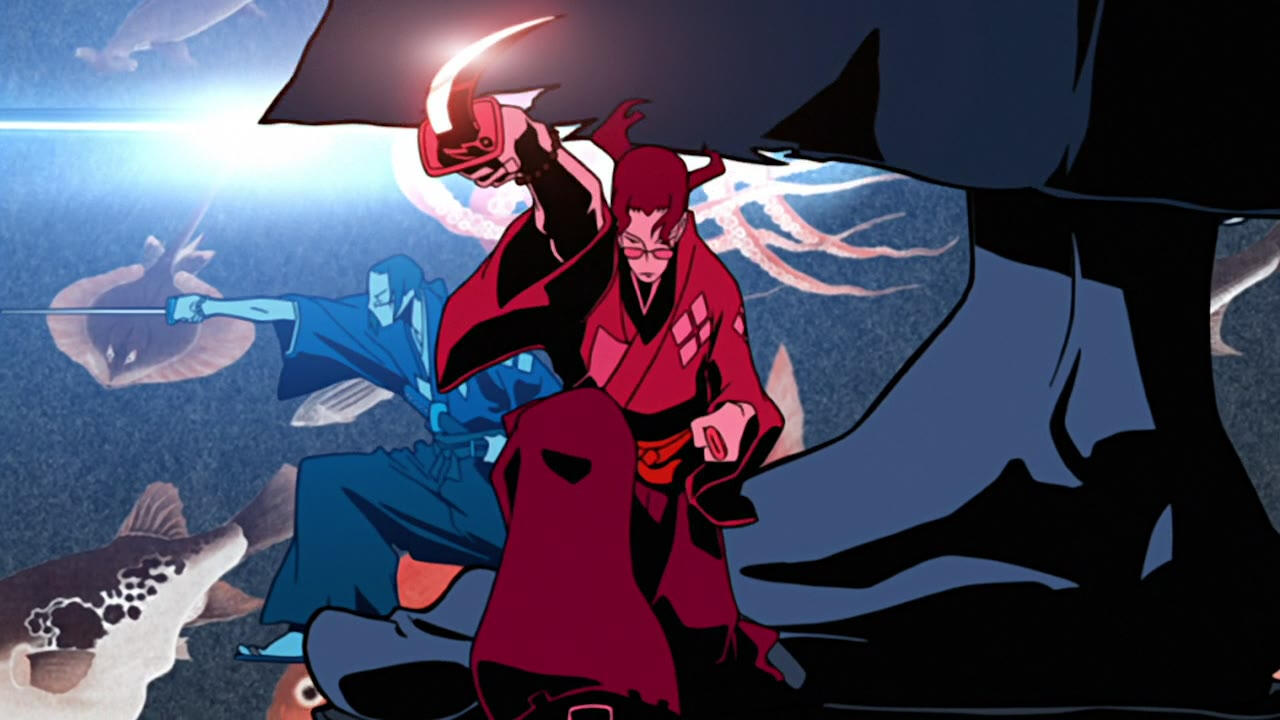
[Continue to Part 3!]
Subverting Chanbara: The Case of Samurai Champloo, Part 1
[Retrospective: I recently rediscovered this paper from my last semester in FSU's Religion Department. At the time, I was enrolled in a course titled "Samurai Ethics," which emphasized the deliberate modern construction of a singular ideological system that came to be known as "bushidō." I was never able to do anything with this one, but it turns out I don't hate the argument as much now as I did when I first wrote it.][Note: Part 1 focuses entirely on my methodological approach and it's a bit dense for my liking now. If you're into Japanese cinema or history, you may want to check it out. If you'd prefer to get into the anime, skip ahead to Part 2. A full list of sources will be included at the end of Part 3.]
Released in May 2004, Watanabe Shinichirō’s Samurai Champloo tells the story of three unlikely traveling companions — Fuu, Mugen, and Jin — and their journey across Japan in search of the Samurai Who Smells of Sunflowers. The twenty-six episode anime series gained popularity amongst American audiences for its novel combination of medieval Japanese and hip-hop cultures, not least because the latter plays a prominent role in its soundtrack, character design, and narrative trajectory. Subsequent analyses of the work, most of which remain confined to the realm of popular discourse, tend to focus on the apparent incongruity of these two thematic elements through a series of simple oppositional binaries: East versus West, Japanese versus Okinawan, and traditional versus modern. As a result, the series’ message has often been reduced to one of discontinuity and irreverence. Jin and Mugen, samurai and criminal, come to represent two opposing worlds, neither of which prove capable of meeting in any meaningful way.In this paper, I push back against these interpretations and argue that the series subverts conventions of the melodramatic chanbara (チャンバラ, samurai films) by inverting expectations of history, morality, and reality through its depictions of its primary and secondary characters. The series is thus concerned more with similarity than difference, a fact that stems from Watanabe’s unique response to “samurai films” and bushidō ideology as a Japanese director embedded within a Japanese context. I consequently begin by nesting my argument among three discourses pertaining to history and film in Japan, including the link between tradition and modernity, the role of melodrama as a form of vernacular modernism, and the oscillation between reality and fiction in anime. Then, I turn toward Mugen, Jin, and a loose grouping of secondary characters and antagonists -- and in each case show that the simplicity of the characters’ superficial appearances and actions is ultimately undermined by a deliberate illustration of their shared moral complexity and embodiment of both past and present.

Tradition versus Modernity
My methodological approach is guided by three interrelated discourses. The first is concerned solely with perceptions of the Japanese transition to modernity, including the ways in which “traditional” culture influenced the composition of both classical and postwar cinema. While it does not explicitly address the film industry, Gerald Figal’s Civilization and Monsters provides an interpretation of the traditional-modern divide that is rather useful in this regard. He argues that the construction of the “fantastic” (fushigi) in Meiji Japan represents a deliberate attempt to “rule by ‘modern reason’ [that recast] past ‘reason’ as well as past and present ‘imagination’ as folly.” One of the “principal [tasks] of Meiji ideology” was thus to “fashion from disparate beliefs in spirits a modern and unified Japanese Spirit,” a project that effectively rooted the present in the past. As a result, Figal presents the relationship between tradition and modernity as neither a harsh break nor a continuously straight line, but rather a weaving path characterized by deliberate transformation along the way. When elements of tradition survive the process, they emerge forever altered in order to meet the needs of an evolving society.Similar arguments about the “survival of tradition” permeate scholarship on early Japanese cinematic history. In his introduction to Noël Burch’s To the Distant Observer, for example, Harry Harootunian describes the volume as a reminder of “the ceaseless process of interaction between past and present where[in] the latter is constantly called upon to conjure the former.” According to him, Burch skillfully showed that “older cultural practices and artistic forms [often] had to be radicalized to make Japan’s modernity something more than simple imitation.” It was for this reason that elements of theatrical forms like kabuki and bunraku inevitably found themselves “pressed into the service of film’s early formation” in any of a number of ways, not the least of which was the survival of live narrators (benshi).Jennifer Coates sees the roles of postwar-era actresses as functioning in much the same way. Stars like Hara Setsuko (1920-2015) and Tanaka Kinuyo (1909-1977) began their careers prior to the outbreak of the Second Sino-Japanese War, and therefore came to prominence as the conflict reached its peak. During the American occupation, major film studios sought to “maintain an element of consistency” by building on this “extant popular appeal,” even as they simultaneously repackaged the actresses’ personae to fit postwar society. The end result was a cinematic culture that provided reassurance and “a sense of connection to the past” to audiences struggling to cope with devastating personal and national loss. Familiar faces onscreen served as tangible reminders that some things still remained the same.By comparison, Darrell William Davis’ discussion of the “monumental style” of Japanese film builds more directly upon Burch’s earlier work. In Picturing Japaneseness, he defines the style as “a prewar cinema permeated by a hieratic, sacramental appropriation of a classical heritage in order to promote an apotheosis of Japanese national identity.” In other words, the monumental style consists of those movies that actively employ (or deploy) pre-Meiji culture to construct and elevate a singular myth of Japan and its people. This “mythologization” is accomplished through the concurrent presence of myriad factors, ranging from the incorporation of certain cinematic techniques (e.g., long takes, moving cameras, etc.) to a concern with sociocultural themes (e.g., bushidō). Perhaps more importantly, Davis also acknowledges that monumental films influenced the composition of postwar cinema; Kurosawa Akira’s Ran deliberately “unravels the indigenous associations of monumental style itself.” Even in the case of comparatively recent films, then, it is possible to trace an unbroken — but hardly unaltered — line from the memory of historical foci to the manifestation of contemporary concerns.This notion of a “transformative continuity” applies to not only the fictional world of Samurai Champloo, but also my own attempt to situate it within the real world of Japanese cinema. Within the series, modernity and tradition prove to be fluid concepts. A cursory glance suggests that they manifest and clash most frequently through the appearances and actions of characters like Mugen (i.e., the modern) and Jin (i.e., the traditional). However, as we will see below, the dichotomy is a false one, and both characters actually embody at least some of the characteristics of their respective counterpart. A related measure of temporal fluidity guides the construction of the series, as a whole. That is to say, Samurai Champloo may be a modern cultural production, but it is a modern cultural production rooted in earlier cinematic and theatrical traditions. Elements of its story, character design, and visual style all exist along a continuum that stretches back through postwar and prewar film to nō, kabuki, and bunraku plays, as well as other ideological concepts (e.g., bushidō) that coalesced around the time of the Meiji Restoration. None reflect contemporary societal concerns in exactly the same way, but all have nevertheless had some impact upon the series’ final form. The end result is a narrative that actively engages with the past in form, despite occasionally rejecting it in content.
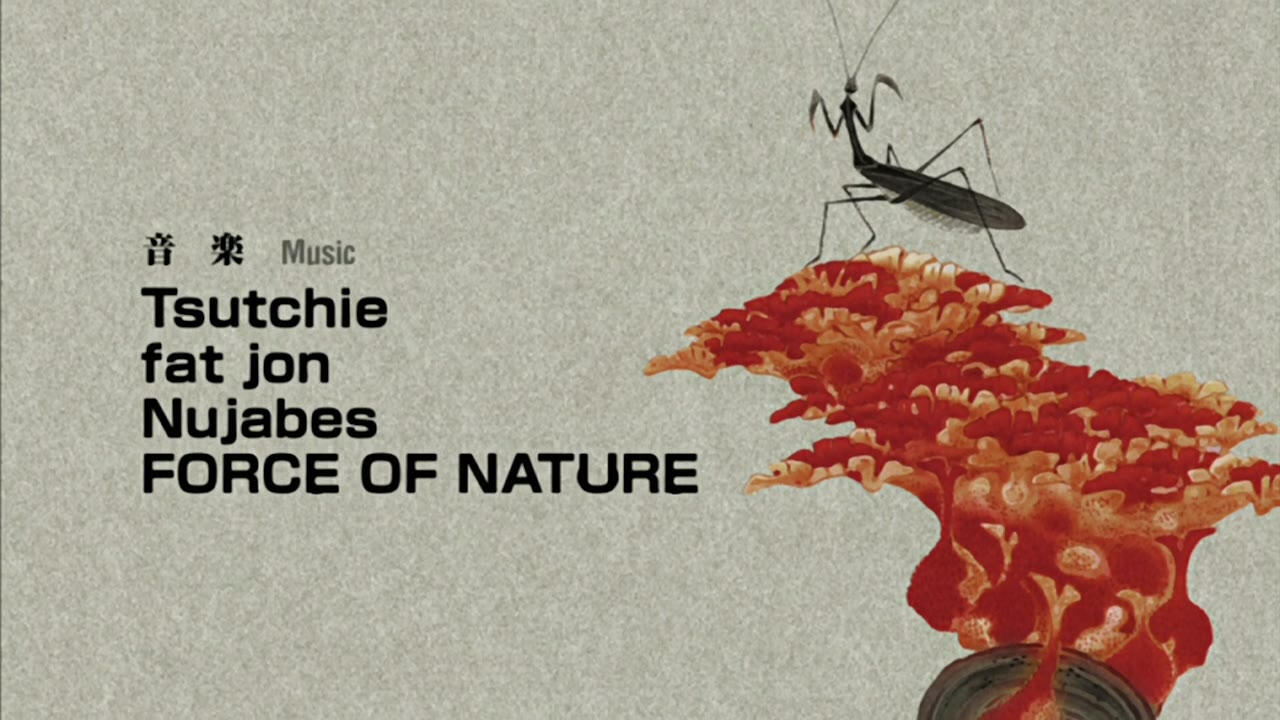
Chanbara versus Melodrama
With this in mind, my argument draws from a second related discourse surrounding manifestations of genre in the Japanese context. Although Samurai Champloo is popularly described as a chanbara-style anime in the West, the overwhelming focus upon its setting, combat scenes, and the “samurai-ness” — or apparent lack thereof — of its main characters has largely led to the neglect of other potential cinematic influences. It is therefore worth considering the series as more than just a modern chanbara variant because of a handful of superficial similarities; instead, we would do well to question the historical and cultural circumstances surrounding the construction of both genre and the genre in Japan, as well as the broader implications of its exportation to the United States (and beyond).Catherine Russell’s reconceptualization of the studio era of Japanese cinema provides a solid foundation for this analytical turn. Drawing on the works of Miriam Hansen and Christine Gledhill, Russell proposes that films of the studio era can be treated as a “parallel form of classicism” through a theoretical framework rooted in the concepts of vernacular modernism and melodrama. The former, she notes, “incorporates the various cultural practices by which the experience of modernity has been articulated and modified,” and thereby situates cinema “alongside the ‘everyday’ discourses and practices that it also mediates.” Put differently, a framework of vernacular modernism insists that films cannot be separated from a given sociohistorical context because they necessarily reflect (and reflect back upon) the institutions that gave rise to them in the first place. Japanese studio-era productions in particular represent the “changing structures of Japanese society” that came about as a result of its response to modernity — and do so through their reliance upon a stock set of visual and thematic principles.Meanwhile, melodrama, which Russell sees as a supplement to vernacular modernism, serves to undermine the very notion of modernity itself. Here she draws from the extensive work of Yoshimoto Mitsuhiro, so it is worth considering his own understanding of the term at some length. According to Yoshimoto, the notion of melodrama is a somewhat vague one, and its characteristics often seemingly contradictory. The term can be applied to both a “generic mode” rooted in socio-economic tragedy or a specific narrative form associated with the romantic opposition of good and evil. Its content appears realistic at first glance, partly because it intentionally “manipulates [an] audience’s emotion by presenting the tension between the possibility and impossibility of the final gratification.” At the same time, though, it exists “beyond [the] reality of daily life.” Meaning is found not in the superficiality of verbal discourse between characters, but rather through the “mood and atmosphere evoked by the mute [bodies of characters] and the environment” that surrounds them. The aforementioned moral conflicts are embodied more than they are articulated, and characters undergo a process of psychological flattening that precludes the existence of any rational complexity in terms of motivation; most are merely pulled forward by “transcendent forces” as “events inexorably unfold themselves” over time.Using these contradictions as a starting point, Yoshimoto outlines a tripartite classification system for melodramas in Japan. He lists the three primary types (and their respective subtypes) as follows:
Conflict between Individual Desire and Social Constraints
Giri vs. Ninjo
Tragic Love Story: Typically Illicit Love
Dilemma of Social Mobility
Power of the Inevitable
Incurable Disease
Inability to Keep Up with Historical Changes / Current of the Times
Helpless Victim and Powerful Villain
Yoshimoto emphasizes that this system can be interpreted either structurally (i.e., as a means of categorizing plot) or historically (i.e., as a chronological trajectory) depending on the film or films at hand. In the case of the former, the three types prove capable of “[accommodating] almost any Japanese film melodrama.” In the case of the latter, they correspond to specific themes of melodrama that emerged in Japan in the mid seventeenth, late-nineteenth, and mid-twentieth centuries, respectively. Both approaches are also inextricably linked with the other, at least to the extent that each of the three types represents a unique socio-political response to a broader concern with modernity. A structuralist application is thus never simply structural, just as a historical application is never simply historical.My analysis builds upon these concepts by treating Samurai Champloo as a reflection of vernacular modernism in melodramatic form. Its loose interpretation of the traditional-modern divide is indicative of Watanabe Shinichirō’s response to the world around him, but it is a world centered largely upon Japan and the Japanese situation at the end of the twentieth century. As a result, we can only hope to interpret the piece — and understand its intended purpose — by considering its form and content as products of Japanese history and culture. Labels like chanbara are useful and necessary, but only if we recognize that the idea of chanbara has come to mean something different in the American context. The so-called “samurai film” is, after all, comprised of more than just a series of choreographed duels between gruff-yet-honorable warriors. Postwar chanbara (and jidai-geki, as a whole) were highly melodramatic, including even the innovative productions of Kurosawa Akira himself; much the same holds true for the early-modern theatrical performances by which they were inspired. And by ignoring or failing to consider the implications of such factors, we risk not only overriding authorial intent, but also reducing Japanese society to the image or few images that we ourselves have constructed.
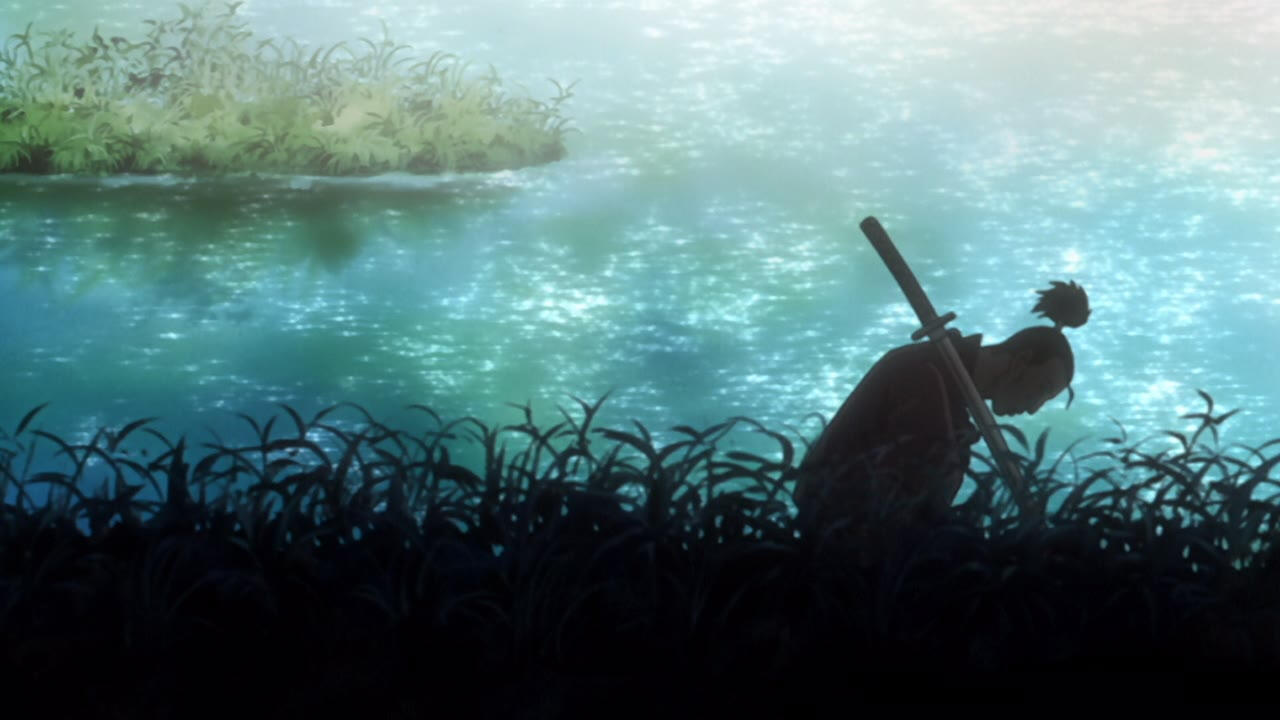
Reading Anime
The third and final discourse connects the preceding discussions of Japanese history and film by dealing directly with the medium at hand: anime. The academic study of anime is a relatively nascent field, and its general viability a source of debate, but I have chosen below to accept its existence and cultural import as matters of course. Meanwhile, my definition of anime and understanding of its characteristics are heavily influenced by the work of Christopher Bolton. In his Interpreting Anime, he adopts a rather loose approach to the former, defining it simply as any “Japanese animation based on a drawn image.” These visual productions, he says, differ from other media (e.g., theatre, art, manga) because they possess a unique “ability to move the viewer very rapidly back and forth between […] two poles of immersion and distance.” Anime consequently allows for some form of “resonance” between the viewer’s world and its own, despite regularly interrupting this immersion through its use of “self-conscious textual devices that call attention to the form of the text itself.” The end result is an ongoing oscillation between “identification” and “alienation” that may or may not be resolved over the course of the narrative.Now, I must admit that I do disagree with certain elements of Bolton’s argument. Undoubtedly the most problematic of these is his insistence that anime is somehow “unusual” or “unique” in comparison to other media. While different media will inevitably reflect different socio-cultural issues in different ways, I find it difficult to believe that anime, as a whole, can ever be entirely separated from manga, its printed counterpart. The same holds true for his attempts to split feature-length anime films from televised anime series, which Bolton says “often fails to generate the [same] kind of oscillation.” Both arguments ultimately serve to undermine the breadth of his earlier definition of anime, and thereby overlook the potential for connections between disparate forms of narrative media.[Retrospective: Reading the first half of this paragraph roughly four years later is strange because now I agree with Bolton. My current research relies almost entirely on the fact that anime and games do bring something different to the playing field in terms of representation and embodiment.]We must also acknowledge that the rapid oscillation between identification and alienation, or reality and fiction, actually mirrors our earlier discussion of melodrama. On the one hand, such a parallel further problematizes the narrative of anime as a particularly “unique” medium. On the other, it further reinforces the way in which we read Samurai Champloo as a particular manifestation of the animated medium. The series’ sustained reliance upon simple binaries is indeed indicative of its position as a melodramatic, chanbara-influenced anime, but it does not mean that it accepts this role blindly. Watanabe instead uses these apparent contradictions to undermine the existence of the categories themselves. Tradition and modernity, giri and ninjo, good and evil, and even fiction and reality all fall apart because he shows that the distinctions within each pairing are little more than artificial constructions. In this way, Samurai Champloo functions as a tale of internal similarity despite external difference, and thereby inverts popular expectations of both content and form at every turn.
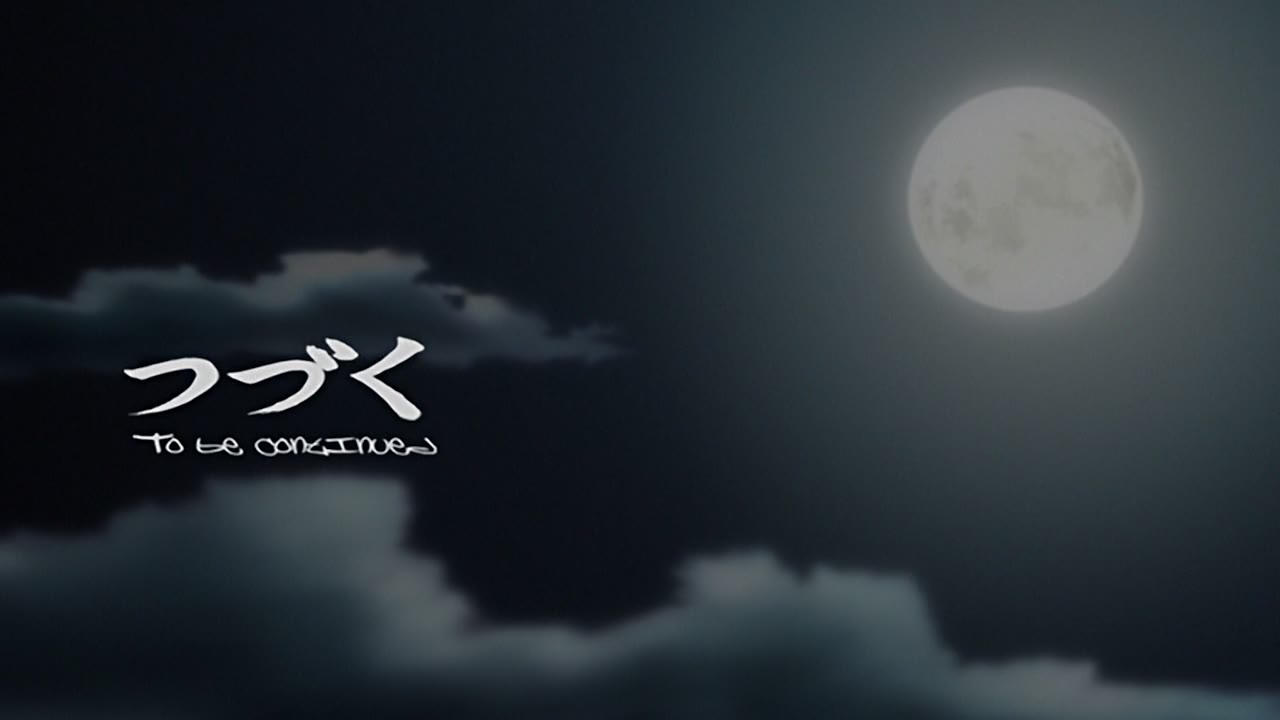
[Continue to Part 2!]
Ms. Marvel and Muslim American Youth
[Retrospective: I wrote this paper back in Spring 2019 for FSU's Graduate Student Symposium. At the time, it was an easy line for my CV, but it also reflected years of my thinking about ethnic and religious identity formation. Although my work has since expanded into broader concerns about the limits of the human and human identity, I don't think I'd have made it this far without working through these very public conceptions of belonging.]
The new Ms. Marvel, a Pakistani American teenager named Kamala Khan, first appeared in her own series in February 2014. The nineteen-issue run almost immediately received critical acclaim for its representation of Muslim American families, a response likely facilitated by the fact that two of the character’s co-creators (Sana Amanat and G. Willow Wilson) know firsthand the experience of life in the United States as Muslim women. While many of their predecessors in the field typically conflated “Muslim” with “Arab,” Amanat and Wilson subvert standard one-dimensional stereotypes in an attempt to create a character that’s familiar -- an “every girl” despite her ethnicity, religion, and super-normal powers.In this paper, I argue that they’re ultimately successful: Ms. Marvel not only remains accessible to the average non-Muslim or Pakistani American reader, but also mirrors and embodies the problems faced by young adults in these populations, as well. In the wake of a literal earth-shattering incident, Kamala finds herself torn between various social forces and forced to reevaluate her self over against those around her. My analysis explores the three primary elements of her hyphenated identity: Kamala Khan, the average American teenage girl; Kamala-beta, the only daughter in a Pakistani American family; and Ms. Marvel, the newly-minted Avenger. I conclude by noting that this seemingly “fractured” self reflects the actual experience of Muslim American youth, and thereby serves as a corrective against the danger of recycled stereotypes and “token” characters in contemporary media. Put more simply, Ms. Marvel seeks not to denigrate those it represents, but to empower (or “embiggen”) them, providing a voice and representation where they’ve rarely existed before.
Ms. Marvel #1-3 (November 2015 - January 2016)
The second run of Ms. Marvel picks up after the events of the world-shattering miniseries known as Secret Wars -- and, at this point, Kamala Khan is relatively new to the superhero business. She gained the ability to enlarge (or, as she says, “embiggen”) and shrink in size after exposure to the gene-altering Terrigen Mist only a short time before the collision of the normal-616 and Ultimate-1610 universes; as a result, she was forced to learn her powers “on the fly.” By the time the mini-series concluded with the restoration of the original Earth-616, she’d become a battle-hardened hero, capable of fighting alongside the likes of Iron Man and Sam Wilson’s Captain America. They'd even made it official: Kamala was now an Avenger.Back in the everyday world of non-powered humans and high school, though, Kamala is forced to juggle her secret life with a relatively normal one. Or, more accurately, two relatively normal ones. As we see in the first post-Secret Wars arc, “Super Famous,” she’s living three lives, perched between her roles as a teenage American girl, the only daughter in a Pakistani American family, and a superhero with far greater responsibility than ever before. When a billboard with a picture of Ms. Marvel appears above a new up-scale commercial development, Kamala is incensed and begins to investigate its owners. She soon learns that the Hope Yards Development and Relocation Association (i.e., HYDRA) has set its sights on something more than real estate investment: the “revitalization” of Jersey City through the use of mind-controlling nanotechnology. The ensuing conflict serves to highlight the nature of Kamala’s tripartite identity, while simultaneously illustrating the significant overlap that exists between her seemingly fictitious experiences and the lives of Muslim American youth today.
Kamala Khan, American Teenager
The first third of the titular superheroine’s identity is that of Kamala Khan, the average American teenage girl. Although long-time fans are undoubtedly familiar with Kamala’s life as a student, the “Super Famous” arc wastes little time in establishing the division between her private and public personas for new readers. The first issue begins with a three-page montage of Ms. Marvel fighting alongside the new Avengers, complete with an inner monologue detailing the ways in which her life has changed since “the world almost came to an end.” But almost immediately, the scene shifts to images of Kamala doing homework and walking through the hallway of her school. Another ten pages pass before Kamala returns to the role of Ms. Marvel.By the middle of the arc, Kamala is sleeping only four hours a night, and has already failed to pay attention in one physics lesson and skipped another entirely. More importantly, she’s learned that Bruno, her best friend and technological assistant, is dating a girl named Michaela (i.e., Mike) despite having loved Kamala. She insists that it doesn’t matter to her, but it soon becomes clear that the heroine harbors some resentment toward the couple. Kamala twice makes comments to Bruno while in the midst of superhero-related activities, calling Mike his “non-tiny girlfriend” and implying that he fills his time with homework, real work, and Mike. When he responds to her by suggesting she actually talk to Mike, Kamala brushes it off: “Some other time, Bruno! I have bad guys to fight.” But it’s a deflection. In the end, Kamala admits that their relationship had come as a surprise and that “she hasn’t really wrapped her mind around it yet.”These experiences and exchanges are significant because they’re all extraordinarily "normal," at least in terms of their accessibility to American audiences. That’s to say, the character of Kamala may speak, in particular, to high school-age women of Pakistani descent, but the broader experience of high school in the United States is a phenomenon that cuts across categories of sex and ethnic or racial identity. Sleepless nights, awkward romances, and jealousy aren’t limited to individuals with superpowers; rather, they’re par for the course among young adults. The depiction of Kamala as a student thus relies on familiar feelings or memories of academic and social pressure in an attempt to humanize the character, both literally (considering her superhuman status) and figuratively (as a way of breaking the aforementioned stereotypes of Muslims in the American context).At the same time, Kamala’s struggle to balance her public/human and private/superhuman personas is meant to reflect the ways in which second-generation Muslim American youths struggle to situate themselves over against their peers. According to Lori Peek, it’s not uncommon for the latter to downplay their religious identities to “‘pass’ as part of mainstream society.” One of her subjects, for example, said that she “identified much less with being Muslim” in high school because she didn’t want to “stick out too much.” She just wanted to “be in the in crowd and do things that [were] considered cool.” This phrasing implies that the student viewed Islam as being incompatible with the “normal” American experience, despite actually being raised in the tradition. For her, it was a matter of picking one over the other; a hyphenated identity wasn’t an option.The same holds true for Kamala, albeit in a slightly different form. Although the character doesn’t necessarily feel forced to choose one identity over another, she’s yet to fully “synthesize” her three roles. Kamala-beta and Ms. Marvel undergo very different experiences from Kamala Khan because Kamala differentiates between each role in her own mind. A recent study by Saba Ozyurt provides some useful conclusions about the implications of this process. For Ozyurt, the separation or fragmentation of disparate identities by female Muslim immigrants isn’t the result of perceived cultural incompatibility (as in the case of the aforementioned student), but rather the accessibility of a “coherent self-narrative of belonging to both worlds.” It’s therefore possible for individuals to construct such narratives in both compatible and incompatible sociopolitical contexts. To do so, however, “an individual has to be competent in both cultures and behavioral repertoires.” In other words, synthesizing seemingly disparate identities takes knowledge and confidence that may not be available or fully-developed at certain points in life — adolescence, for example. The teenaged Kamala lacks these qualities because she doesn’t possess the same depth of experience as a second-generation immigrant five or ten years her senior. Only with time can she become fully capable of crafting a stronger, more cohesive self-narrative.
Kamala-Beta, Devoted Daughter
In addition to her life as a normal American teenager, Kamala also plays the role of beta, the devoted child of first-generation immigrants from Pakistan. This carries with it an entirely different set of cultural and religious expectations. One night, for example, Kamala returns home after curfew and is immediately confronted by her mother, Muneeba. Rather than scolding her daughter for disobeying her rules, she instead draws her attention to the negative publicity surrounding Ms. Marvel and the Hope Yards billboard. She then insists Kamala take a break from fighting crime and reminds her that a hero without the support of the people is simply a lafungah, “a useless idiot who has failed at life.”[Note: In Urdu, betā ( بیٹا ) and betī ( بیٹی ) technically refer to “son” and “daughter,” respectively. However, betā can also be used by adults to address both men and women of a younger age. Kamala’s mother uses the term in this arc, but her father has said it in previous issues, as well.]On another occasion, Kamala informs her friends that she’s late to a meeting with her older brother, Aamir, at the local mosque. She ultimately fails to arrive (thanks to trouble with some criminals), but Aamir catches her leaving home the next morning and asks her to chaperone a meeting with a young woman named Tyesha. As he admits, he cannot talk to Tyesha “for the purposes of discussing marriage” without “correct supervision.” Kamala reluctantly agrees to “be a good mahram” and accompany Aamir on “[his] non-date with [his] non-girlfriend.”The use of non-English terms is important here. Lafungah and mahram both reflect ideas or practices that exist apart from the American norm, and thereby highlight the extent to which Kamala-beta is defined by elements of Pakistani and Islamic culture. Put differently, their meanings are more accessible to members of their respective populations and serve to create a link between those capable of understanding them. The use of lafungah, for example, received praise from Wajahat Ali, a notable Pakistani American playwright and journalist. In a tweet from 24 December 2015, Ali wrote, “@GWillowWilson’s MS. MARVEL #2 uses the word ‘lafungah.’ Tear of pride.” Kamala-beta’s mahram duty of chaperoning Aamir and Tyesha is similarly accessible, albeit to a broader Muslim audience, because it’s actually rooted in Islamic marital laws and the ways in which they’ve been enacted in various countries throughout the world. Of course, the scene does also appear to specifically reflect the practice of “semi-arranged” marriages in Pakistan, and could therefore comprise multiple levels of belonging (e.g., Pakistani / Pakistani American and Muslim) at the same time.The problem is that the inclusion of one group demands the exclusion of another. In this case, the aforementioned markers of Pakistani and Muslim identity preclude Kamala-beta from fully assimilating to the life of an average American teenager. While she might be able to relate to the more common experiences and pressures of high school, the same can’t be said with regard to her classmates and her own ethnic and religious background. They’re largely incapable of relating to the latter because they lack the same forms of socio-cultural capital that Kamala-beta’s accrued throughout her life. As a result, she herself is “excluded from the informal feeling of collective membership and group solidarity” that binds the (non-Pakistani and/or non-Muslim) majority in the United States.Nor are such experiences merely limited to the pages of comic books. Building on the scholarship of Leti Volpp, Yaser Ali argues that Muslim Americans “were stripped of their citizenship as identity” in the wake of the events of 11 September 2001. They were, of course, still legally defined as citizens, but their status as such meant little in light of their interpellation as the “other” in the public and private spheres. Ali also points toward a sizable body of statistical and anecdotal evidence to support his claim, ranging from an “immediate” spike in anti-Muslim violence in Winter 2001 to allegations that President Obama was a Muslim in 2008. This is significant for our purposes as Kamala is not persecuted for her ethnic background or religious beliefs; instead, it’s Ms. Marvel who becomes the target of the public’s ire. However, the difference between the fictional and non-fictional accounts serves to throw the problems that Muslim Americans face into starker relief. Thus, Kamala-beta’s experiences as a racial and religious minority may not directly reflect the real world in the same way as her normal teenage life, but they nevertheless hold meaning for readers as a source of hope for change.
Ms. Marvel, Avenger
Lastly, and most obviously, Kamala maintains the pseudo-secret identity of Ms. Marvel, the young Avenger. Two points are worth noting here. First, the role of Avenger brings with it a new measure of responsibility, one that stems from a formal acceptance by (and sense of belonging to) a broader group. We’ve already seen that this involves assisting other members of the team on missions, but the commitment appears to extend much further. According to Kamala, she’s had to undergo “all [of] the fancy Avengers combat training” in her spare time; it’s partly for this reason that her sleep schedule has suffered. Even Doctor Faustus, the antagonist of the arc, seems to be aware of the additional workload. He reminds Kamala that “running with the Avengers entails a great deal of […] pressure,” and suggests it may have caused her to rise “too far, too fast.”At the same time, the existence of Ms. Marvel necessarily implies a deliberate choice to be Ms. Marvel. There’s nothing stopping Kamala from just “hanging up the costume” and living like a normal teenage girl. She’d still possess shape-shifting powers, but we’ve already seen that they’re significantly less visible than, say, the green-tinged skin of an enraged Hulk. She could easily blend into society, just as she does at school on a daily basis, and thereby remain relatively free of the pressure that comes with ensuring its wellbeing. But Kamala instead insists upon using her gifts to protect others, regardless of the physical or mental harm she might incur in the process. In fact, she likens it to being “on-duty,” not unlike any human law enforcement official. This phrasing suggests that Kamala chooses to maintain the persona of Ms. Marvel because she feels a moral obligation to act; she believes it’s the right thing for someone with her abilities to do.And while there’s obviously not a direct parallel to a secret, super-heroic identity amongst Muslim American youth, I would argue that this deliberate commitment to a larger group mirrors the intentional nature of religious identity amongst second-generation immigrants. According to Lori Peek, the transition to adulthood typically brings with it a heightened sense of religiosity; the majority of participants in her study “agreed that beginning college marked the most critical period of reflection and identity transition.” Two individuals, Zoya and Ali, even noted that their decisions to re-emphasize their Muslim identities were facilitated by the freedom of college, as well as their interactions with other Muslim individuals on campus. The ability to choose to share experiences with like-minded individuals, which occasionally took place in the structured context of Muslim Student Associations (MSAs), inevitably served to reify their “emerging religious [identities].”Ms. Marvel and the Avengers provide Kamala with a similar measure of freedom. As a normal teenage girl or second-generation immigrant, she’s bound by the expectations of others, and forced to act in ways that meet these expectations. As a superhero, though, she literally has the power to operate outside of the law. Freedom is part and parcel of the experience. And with it, she chooses not to abandon her duties or operate alone, but to join an organization capable of providing structure and guiding her through a life devoted to serving others. An organization that is comprised of individuals like her in terms of not only their physical power, but also their dedication to a greater good. In this way, Kamala embodies those young adults who willingly identify as Muslim, despite possessing the ability to “walk away” and assimilate into mainstream society. She chooses to make Ms. Marvel a significant part of her self-identity, even if it means she’ll face additional difficulties in other aspects of her life.
Concluding Thoughts
The character known as Ms. Marvel marks a departure from previous depictions of Arabs and Muslims in popular culture. As I’ve argued here, the young heroine actually plays three separate roles, namely those of Kamala Khan, a normal American teenager; Kamala-beta, the daughter of Pakistani Muslim immigrants; and Ms. Marvel, the superhero-slash-Avenger. Each of these embodies a unique aspect of the lived experiences of Muslim American youth today; together, they reflect the tension that can exist between the desires to “be American” and remain true to a minority culture. Ms. Marvel thus refuses to minimize the complex nature of identity formation amongst its target audience, and thereby provides much-needed representation to a much-maligned segment of the American population.
Additional Reading
Ajrouch, Kristine J., and Amaney Jamal. “Assimilating to a White Identity: The Case of Arab Americans.” The International Migration Review, Vol. 41, No. 4 (Winter 2007): 860-879.Ali, Yaser. “Shariah and Citizenship — How Islamophobia is Creating a Second-Class Citizenry in America.” California Law Review, Vol. 100, No. 4 (August 2012): 1027-1068.Berlatsky, Noah. “What Makes the Muslim Ms. Marvel Awesome: She’s Just Like Everyone.” The Atlantic. Published March 20, 2014.“Comic Heroine Ms. Marvel Saves San Francisco From Anti-Islam Ads.” NBC News. Published January 27, 2015.Council on American-Islamic Relations. “New CAIR Report: Trump’s Muslim Bans Increased Anti-Muslim Discrimination, Violence.” CAIR. Published April 23, 2018.Fleckenstein, Kristie S. Embodied Literacies: Imageword and a Poetics of Teaching. Carbondale, IL: Southern Illinois University Press, 2003.Groensteen, Thierry. The System of Comics. Translated by Bart Beaty and Nick Nguyen. Jackson, MS: University Press of Mississippi, 2007.McCloud, Scott. Understanding Comics: The Invisible Art. New York, NY: HarperPerennial, 1994.Ozyurt, Saba. “Negotiating Multiple Identities: Constructing Western-Muslim Selves in the Netherlands and the United States.” Political Psychology, Vol. 34, No. 2 (April 2013): 239-263.Peek, Lori. “Becoming Muslim: The Development of a Religious Identity.” Sociology of Religion, Vol. 66, No. 3 (Autumn 2005): 215-242.Pumphrey, Nicholaus. “Niqab not Burqa: Reading the Veil in Marvel’s Dust.” In Muslim Superheroes, edited by A. David Lewis and Martin Lund, 20-39. Cambridge, MA: Harvard University Press, 2017.Shaheen, Jack G. Reel Bad Arabs: How Hollywood Vilifies a People. New York, NY: Olive Branch Press, 2001.Valderrama, Pepi. “Geek Anthropology of Ms. Marvel.” dePepi.com. Published May 11, 2015.Wilson, G. Willow. Ms. Marvel, #1-3. New York, NY: Marvel Comics, 2015.Wright, Bradford W. Comic Book Nation: The Transformation of Youth Culture in America. Baltimore, MD: The Johns Hopkins University Press, 2001.
Contested Boundaries and Conflicting Identities in Marvel's Luke Cage
[Retrospective: Like my other post on Ms. Marvel, this one's pretty old. I wrote it in Fall 2017 for the South Central MLA Conference, which was my first "real" conference outside of graduate symposia. The paper itself was also the first time I'd tried to present something unrelated to my research in college, so I was more than a bit nervous -- I even went in for a bit of bourbon before my early afternoon presentation...]
The character known as Luke Cage, or Power Man, first appeared during the rise of Blaxploitation films in the early-1970s. Marvel’s Luke Cage repositions the eponymous superhero within the broader Marvel Cinematic Universe, a realm split by growing division between powered and non-powered humans. In the wake of the events of Jessica Jones, Cage has retreated into hiding and now seeks to rebuild his life in Harlem. Before long, though, figures from his past resurface and he's forced to confront not only the world outside, but also the self he sought to leave behind.My paper explores the ways in which Luke Cage attempts to negotiate his religious, social, and ethnic identities over against the boundaries imposed by the individuals and institutions around him. I argue that in each case, Cage de-emphasizes the respective identification in favor of some measure of anonymity and, more importantly, normalcy. But, as he's thrust into conflict with Diamondback, non-powered humans, and a white, militarized police force, he's progressively stripped of any real semblance of agency, and effectively rendered powerless. It's only when he finally faces and overcomes these artificial boundaries that he manages to reclaim his real strength.
Identity Formation
Identity formation is popularly understood as an internal process. We tend to believe that we maintain control over our identities because we choose to define ourselves in certain ways. An individual might, for example, identify as Korean because her parents were born in South Korea, even if she herself was born in the United States or Australia. Another might consider himself to be a musician because he plays bass at a local bar every weekend, even if he works as an electrician during the weekdays. Both choose their own identities by emphasizing the factors they consider to be most important in their lives.But the process doesn't stop there. Without knowing another person fairly well, we cannot instinctively know how she views herself. We instead use visual cues — age, height, weight, sex, skin tone, and clothing — to categorize and stereotype before we have the opportunity or ability to fully appreciate her sense of self. We might therefore label our first example “Asian” because of her appearance, regardless of whether or not she ever thinks about herself as part of a broader Asian community. As a result, her attempt at identity formation becomes multi-directional in nature. Although she understands and projects herself in one way (i.e., Korean), we impose our own image of her identity (i.e., “Asian”) back upon her.The problem with external categorization is that it necessarily minimizes or disregards the emphases of the individual. In some cases, the resulting impact can be relatively small. If we mistakenly identify our musician as an electrician, for instance, he could very well correct us but likely will not be too upset. According to sociologist Mary Waters, much the same can be said about the ways in which white Americans view their own ethnicity. For her subjects, third- and fourth-generation Catholic European-Americans, ethnic identity was largely voluntary and symbolic. It was something that brought pleasure to individuals because it allowed them to feel like part of a “special” community. Mis-identification was thus more likely to harm their sense of pride than their social or economic wellbeing.The same can't be said for all groups. Waters also argues that “the ways in which ethnicity is flexible and symbolic and voluntary for white middle-class Americans are the very ways in which it is not so for non-white and Hispanic Americans.” For the latter, “the situation is very different” because their “lives are strongly influenced by their race or national origin regardless of how much they may choose not to identify themselves in ethnic or racial terms.” Skin tone and other physical attributes overwhelm nearly every other cultural factor members of these groups attempt to use to establish a unique identity. Like our example, then, they're forced to accept the labels given to them, and thereby stripped of the ability to define themselves.
Identity in Marvel's Luke Cage
In Marvel’s Luke Cage, the titular character attempts to exert this freedom by deemphasizing his religious, social, and ethnic identities. And this isn't particularly surprising. Cage is a wanted man, a former Marine and cop framed for a crime he did not commit. As we later learn, he was sentenced to Seagate Prison, coerced into joining an illegal fighting ring, subjected to an unethical experiment — one that gave him super-strength and unbreakable skin — while on the brink of death, and is now hunted for escaping. All he wants now, he tells Pop, is to “sweep hair, wash dishes, and be left the hell alone.”Of course, he's not given this opportunity.
Religious Identity
With regard to his religious identity, Cage’s most daunting obstacle comes in the form of Willis “Diamondback” Stryker, the primary antagonist of the series. And there's a bit of history here. Cage was born Carl Lucas, the son of Etta and the Reverend James Lucas of Savannah, Georgia. His closest friend was the young Willis, son of James’ secretary, Dana Stryker, and, of course, James himself. Although Cage was unaware of their relationship until much later, Willis always knew that he and Cage were half-siblings. As Diamondback later says, “I just wanted [my father] to see me. I was a good boy. I did well in school. But he always loved Carl more.”Luke disagrees. He argues that “Willis hates me because my father hates the idea of him. What he doesn’t realize is that my father never really liked me very much either.” In fact, when Cage was sent to Seagate, James refused to respond to his letters, and seems to have written him off entirely. Cage, as a result, has not attempted to contact his father since the escape.It's this relationship that provides insight into the way Cage approaches religion. For him, James and religiosity are essentially the same, not least because the former was a pastor. Any references to the Bible serve to remind Cage of his father, and this is undoubtedly why he invokes it so infrequently throughout the series. Over thirteen episodes, our hero cites Luke 4:18 once and Genesis 4:9 (“Am I my brother’s keeper?”) twice, all in reference to his father or half-brother. He also calls Diamondback his “cross to bear” on one other occasion. Each suggests a burden that can be linked back to his father and is cited only when Cage is forced into a situation not of his choosing. He refuses to engage with religion until he's effectively made to do so.Diamondback acts as that catalyst. Unlike Luke, he embodies the religion of their father. In seven episodes, he makes a wide range of biblical references, citing Proverbs 18:24, Matthew 24:10-13, and Revelation 6:8. He refers to himself as a “snake” and “the angel of death,” and calls Cage “a false idol” and “golden calf.” During the hostage situation at Harlem’s Paradise, we learn just why he uses this language. Diamondback hands Damon Boone, a local councilman, a copy of the Bible, one that originally belonged to the Reverend James. As Boone flips through its pages, we see that certain passages are color-coded, while others are heavily annotated and circled or underlined. It's the Bible of a delusional man, one who has lost his grip on reality simply because he wanted to gain favor with his father. And since he wasn't able to do that, he blames and confronts his half-brother, forcing Luke to come face-to-face with the religious identity he'd hoped to leave behind.
Social Identity
Much the same takes place when Cage attempts to de-emphasize his social identity, the superpowers by which he tends to be defined. As we saw before, he's initially hesitant to use these abilities to help people because he doesn't want to be discovered. When he sees Shades, another inmate from Seagate, at Harlem’s Paradise, Cage immediately returns to his apartment and begins to pack to leave town. Not long afterward, Pop asks him to locate Chico, one of the three young men who robbed Cottonmouth, and ensure his safety. Our hero initially tells him to just forget about Chico, and only changes his mind when Pop collects on a debt. As Cage later says, “I laid in the cut until he [Pop] stepped up.”In fact, it isn't until Pop is killed by Tone, an enforcer working for Cottonmouth, that Luke is finally spurred into action. Within little more than a day or two, he shuts down a number of the crime lord’s safe-houses, including the Crispus Attucks Complex, and thereby cripples Cottonmouth’s financial assets. Cage continues to fight for the people of Harlem until Cottonmouth is arrested, but makes a point of claiming that “he ain’t no hero.” All that mattered to him was that he “did right by [Pop].” With that task complete, he tells Claire, he's “done.”Here, we see that Luke again refrained from acting until the absolute last moment, if not somewhat later. He may have played a key role in dismantling Cottonmouth’s empire, but only did so because Tone killed Pop. At that point, he had to embrace his superpowers to protect those still around him -- and when all was seemingly said and done, he showed little intention of continuing to be a public hero. Instead, he turned his sights back toward the life of relative normality that had been taken from him.
Ethnic Identity
This leaves the ways in which Luke Cage de-emphasizes his ethnic identity. Although I normally prefer to define this term a bit more broadly, my focus here is specifically the experience of being black in Harlem. This is because, as Mariah Dillard puts it, “Harlem has been the jewel of black America.” As we see in the series, it's a place of significant culture, one that's marked by former institutions (i.e., the Cotton Club) as much as it is by its famous inhabitants (i.e., Dapper Dan). At the same time, it's a real community, a place of family and friendship where everybody knows their neighbors.But Luke initially seems to have minimized his presence in this community. We learn fairly quickly that he's lived and worked in Harlem for almost half a year, but he doesn't seem to have any close friends aside from Pop. Some residents later claim that they know him from the barbershop, but, as we've seen, we're led to believe that he keeps to himself. This eventually proves problematic. Cottonmouth, for example, accuses Cage of knowing nothing about Harlem, while Misty, a local detective, tells him to “either be a part of the solution or leave.” To them, he's an outsider, both because he moved to Harlem and because he didn't seem to want to belong.After he's accused of assaulting two police officers and killing a third, though, Luke isn't allowed to remain apart from Harlem. And there are two forces acting on him at this point. On the one hand, he's pushed into the category of “black Harlemite” by local law enforcement. They launch a community-wide manhunt and actually equip themselves with special rounds (“Judas bullets”) capable of piercing his skin. On the surface, the NYPD is just trying to level the playing field because they can't hope to stop him without these weapons. But the undertones of racism are impossible to miss. As Diamondback argues, “black fear” was “how gun laws got enacted in the first place” and is exactly why the police will want to arm themselves against Cage.As Luke is being pushed into this category, the community responds by pulling him closer. They commiserate, and it's clear they do so because they've experienced the same mistrust from and mistreatment by law enforcement. As Method Man points out, “bulletproof always gonna come second to being black.” Misty agrees, even though she's a detective herself. When one of her colleagues asks why an innocent man would run, she responds with sarcasm: “He’s a black man being chased by the cops with special bullets. Accused of killing a cop and you’re asking why he’s running? Come on.” Meanwhile, hoodies with bullet-holes, mirroring the ones worn by Cage, gain popularity as a way of showing support and confusing the police. In effect, he becomes a part of Harlem because Harlem becomes him.
Reclaiming Agency
And so Luke Cage is left powerless. Diamondback has forced him to confront his religion, Cottonmouth has forced him to embrace his superpowers, and the NYPD has forced him to become a real part of Harlem. He didn't make these choices freely. He would have preferred to have just been left alone. He wanted to deemphasize his religious, and social, and ethnic identities, but he was stripped of this ability by the people around him.In the final episode, though, he fights to regain control. After Diamondback tracks Luke to Pop’s Barber Shop, the two begin to brawl, and eventually they face off on the streets of Harlem. The battle becomes a spectacle, ringed by journalists, members of the militarized police force, and locals groaning every time Cage is hit. Throughout, the latter shout words of encouragement to the hero: “Don’t give up, Luke,” “Finish him off, Luke,” “You can get him, Luke,” and “Kick his ass, Cage.” The NYPD, on the other hand, refuses to target Diamondback, even when Misty asks them -- her ostensible colleagues -- to intervene. As Mariah Dillard proclaims, “This is nothing less than a battle for the soul of Harlem.”At the same time, it's a battle for agency and freedom. Although we've seen that Diamondback serves as the living embodiment of the religion of their father, here he takes on additional roles. In this fight, he also represents the head of the criminal world in Harlem, the very element that killed Pop and pushed Luke into accepting his powers. And he's equipped himself with a suit designed by Hammer Industries, the creators of the “Judas bullets,” which effectively transforms him into a living weapon designed to kill Cage. Diamondback consequently serves as an extension of the approach taken by the NYPD, one that made Luke fear for his life and pushed him to embrace Harlem. In other words, we see that Diamondback now personifies each of the three obstacles that prevented Luke from making his own choices, and it's only when he confronts these obstacles head-on that he's truly able to overcome them.For that reason, I think it's worth ending with a quote from the encounter, one that both embodies and represents a resolution to this process of identity reclamation. I've already mentioned that, at various points, Luke cites Genesis 4:9, thereby implying he feels responsible for (or is driven to feel responsible for) the actions of his brother. But, at the end of the battle, Luke looks down on a defeated Diamondback and asks himself once more. “Am I my brother’s keeper?"And this time he answers himself: “No, I’m not.”
Additional Reading
Papish, Laura. "Promoting Black (Social) Identity." Social Theory and Practice, Vol. 41, No. 1 (January 2015): 1-25.Prince, Sabiyha Robin. "Changing Places: Race, Class, and Belonging in the 'New' Harlem." Urban Anthropology and Studies of Cultural Systems and World Economic Development, Vol. 31, No. 1 (Spring 2002): 5-35.Waters, Mary C. Ethnic Options: Choosing Identities in America. Berkeley, CA: University of California Press, 1990.Wimmer, Andreas. Ethnic Boundary Making: Institutions, Power, Networks. Oxford, UK: Oxford University Press, 2013.